Australian
and international
exploratory
performance and
media arts
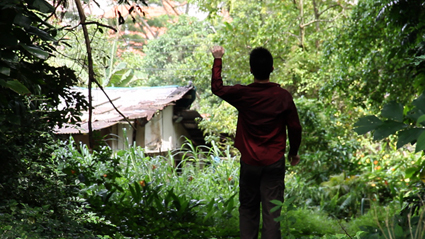
Sarah Kaur, 2011 Resident, Singapore, still, Kampong Buangkok, featuring Guohui Chen
Asialink Arts Residency Program
Applications are now open for Asialink’s program which offers artists and artworkers three-month residencies in a range of Asian countries. There are a number of established relationships with host organisations or artists may initiate their own residency-host arrangements with arts organisations in specified countries.
Deadline 30 September, http://asialink.unimelb.edu.au/arts/residency_program/2014_asialink_arts_residency_program_application_information
MONA Scholarships
Another of the many things that MONA [Museum of Old and New Art, Hobart] has done to invigorate the cultural life of Tasmania is the MONA Scholarship. It provides an emerging Tasmanian artist with $12500 to buy materials and equipment to present an exhibition at MONA in the Library Gallery. MONA also selects one piece of work for its permanent collection.
Applications close 23 August; http://www.mona.net.au/scholarship
Gasworks Midsumma call for works
Gasworks is now calling for applications for productions to take place as part of the 2014 Midsumma festival celebrating queer culture running 12 Jan to 2 Feb. Some shows meeting certain conditions may be eligible for discount hiring rates.
Applications close 16 September; http://www.gasworks.org.au/applications-for-midsumma-2014-eois-now-open
2013 Expanded Architecture at the Rocks
The Expanded Architecture team and Rocks-Pop-Up project is calling for “spatial art practitioners (artists & architects) to undertake a one month residency which will culminate in an exhibition, catalogue and symposium as part of Sydney Architecture Festival. Proposals are sought for projects that draw on the Rocks as site but can be exhibited in the indoor Rocks-Pop-Up site (yet to be confirmed). Academic papers are also being called for.
Applications due 26 August; http://expandedarchitecture.com/
Still in the loop
Metro Screen Seminars
Are You Indigenous And Want To Work In Film And TV? information session, 6 August; Story World Seminar, 9 August
http://metroscreen.org.au/7-events-opportunities-you-dont-want-to-miss/
2high Festival 2013 Artist Call Out
Applications close 16 August
http://www.backbone.org.au/2high-festival.cfm
Bundanon Artist Residencies
Applications close 2 August
www.bundanon.com.au/content/residencies
PauseFest
Registration and final design submission August 15
http://pausefest.com.au/download_docs/pausefest2014_eoi_details.pdf
Tele Visions, call for screen works
Applications close 29 August
http://televisionsproject.org/
Australia Council upcoming deadlines
(for full list see http://www.australiacouncil.gov.au/grants)
Emerging and Experimental Arts: Creative Australia – New (Art Creative Development), 01 August 2013
http://www.australiacouncil.gov.au/grants/2013/inter-arts-creative-australia-new-art-creative-development
Theatre: Cultural Leadership Skills Development, 5 August 2013
http://www.australiacouncil.gov.au/grants/2013/cultural-leadership-skills-development-theatre
Theatre: New Work, 5 August 2013
http://www.australiacouncil.gov.au/grants/2013/theatre-new-work
Theatre: Fellowships, 5 August 2013
http://www.australiacouncil.gov.au/grants/2013/theatre-fellowships
Creative Australia – Emerging Presenter, 12 August 2013
http://www.australiacouncil.gov.au/grants/2013/Creative-Australia-Emerging-Presenter
Creative Australia – New Digital Theatre, 12 August 2013
http://www.australiacouncil.gov.au/grants/2013/Creative-Australia-New-Digital-Theatre
International Markets – Music managers (Previously Live On Stage – Music Managers). 14 August 2013
http://www.australiacouncil.gov.au/grants/2013/international-markets2-music-managers-14-aug-2014
Dance: Artform Development, 16 August 2013
http://www.australiacouncil.gov.au/grants/2013/dance-artform-development
Dance: Fellowships, 16 August 2013
http://www.australiacouncil.gov.au/grants/2013/dance-fellowships
Dance: Projects – Creative Development, 16 August 2013
http://www.australiacouncil.gov.au/grants/2013/dance-projects-creative-development-16-august
Dance: Projects – Presentation, 16 August 2013 http://www.australiacouncil.gov.au/grants/2013/dance-projects-presentation-16-august
Dance: Creative Australia – New Work, 16 August 2013
http://www.australiacouncil.gov.au/grants/2013/dance-creative-australia-new-work
Visual Arts: Skills and Arts Development – Residencies, 19 August 2013
http://www.australiacouncil.gov.au/grants/2013/visual-arts-skills-and-arts-development-residencies
Visual Arts: Presentation and Promotion, 21 August 2013,
http://www.australiacouncil.gov.au/grants/2013/visual-arts-presentation-and-promotion
Visual Arts: Skills and Arts Development – General, 21 August 2013
http://www.australiacouncil.gov.au/grants/2013/visual-arts-skills-and-arts-development-general
RealTime issue #115 June-July 2013 pg. web
© RealTime ; for permission to reproduce apply to realtime@realtimearts.net
A super loop to tide you over till late August while we’re pumping out the RT116 Arts & Education edition.
Darwin Festival
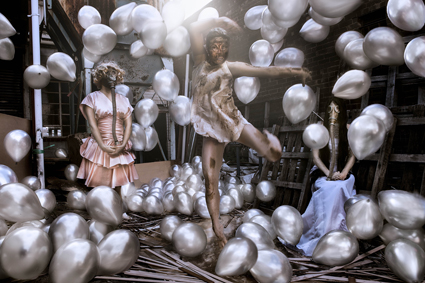
DasSHOKU SHAKE!, Yumi Umiumare & Theatre Group GUMBO
photo Vikki Shayen
DasSHOKU SHAKE!, Yumi Umiumare & Theatre Group GUMBO
If Spring is taking too long to come to you head north to Darwin and take in the festival. Yumi Umiumare presents the latest work in her DasSHOKU series, DasSHOKU SHAKE!—an absurdist Butoh cabaret created with Theatre Group GUMBO from Japan. Queensland ensemble Polytoxic present their site-responsive performance/installation Trade Winds down at the waterfront. Several touring works land in Darwin: Roslyn Oades’ I’m Your Man, Shaun Parker’s Happy as Larry and Ilbijerri Theatre Company’s Jack Charles vs the Crown. Darwin’s own Tracks Dance Company will present a new work, Zombies in the Banyan Tree, creating “a world of opposing forces, where popular culture and tradition collide” (website). RealTime Managing Editors Keith Gallasch and Virginia Baxter will also be in town reporting on the festival and conducting a workshop with local writers.
Darwin Festival, 8-25 August; www.darwinfestival.org.au
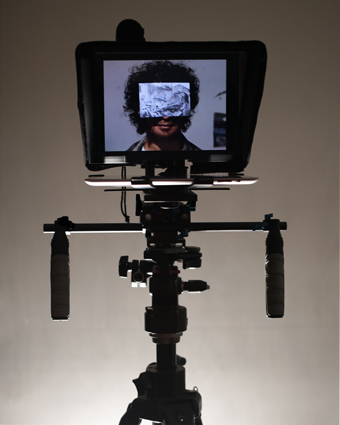
Hydra Poesis, Prompter
photo Sete Tele
Hydra Poesis, Prompter
Arts House Season 2
The second half of the year at Arts House, North Melbourne Town Hall is populated with many wonders. Kicking off the season is Prompter by Perth company Hydra Poesis, an ambitious work of “magic-political-(quasi-science-fiction)-realism” (website) involving dance, performance and broadcast (9-18 Aug; see RT97). Side Pony Productions presents The Confidence Man, a Hitchcockian tale acted out by the audience in large masks with headsets (28 Aug-Sept 1). Olaf Meyer works with the building itself in his projection installation Permanent vs Impermanent 2 (28 Aug-2 Sept). Later in the season there are multiple Melbourne premieres: Roslyn Oades’ I’m Your Man (4-8 Sept, see RT107); Branch Nebula, Matt Prest and Clare Britton’s Whelping Box (4-8 Sept, see RT112); Ilbijerri, Belvoir and Version 1.0’s Beautiful One Day (26 Nov-1 Dec) and Andrée Greenwell, Jordie Albiston and Abe Pogos’ music theatre work The Hanging of Jean Lee (7-8 Dec, see the 2006 RT73 interview and RT75 review). There’s also the world premiere of Stephanie Lake and Robin Fox’s A Small Prometheus as part of the Melbourne Festival (15-20 Oct). To round it off the forum Is Art for Art’s Sake? looks at participatory performance making (13 Sept).
Arts House, North Melbourne Town Hall and Meat Market, August-December; www.melbourne.vic.gov.au/artshouse
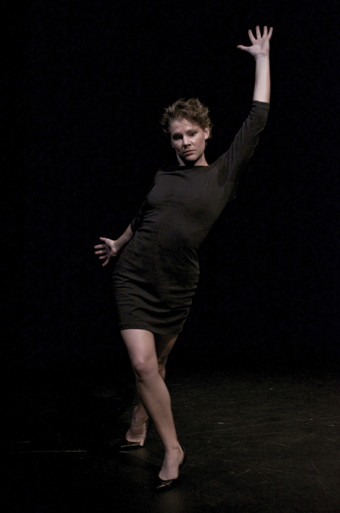
Miranda Wheen, Vitality, Dirty Feet & Chronology Arts
photo Heleana Genaus
Miranda Wheen, Vitality, Dirty Feet & Chronology Arts
Vitality, Dirty Feet & Chronology Arts
Focused on creating opportunities for emerging practitioners these two companies have come together to investigate the relationship between choreographer and composer. Quest, the result of the collaboration between Martin del Amo and Alex Pozniak and performed by Miranda Wheen, was well received during Aurora 2012 (see RT109 and is getting the redux treatment in the upcoming The Little Black Dress Suite, see our Martin del Amo interview). There are also new pieces by the collaborative teams of Kathryn Puie working with Daniel Blinkhorn and Sarah-Vyne Vassallo with Andrew Batt-Rawden.
Vitality, Dirty Feet & Chronology Arts, Seymour Centre, 8-10 August; http://www.seymourcentre.com/events/event/vitality/
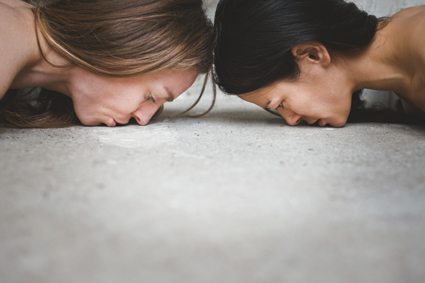
Floored, Victoria Chiu (with Amelia McQueen)
photo Lucy Spartalis for Dancehouse
Floored, Victoria Chiu (with Amelia McQueen)
Floored, Victoria Chiu, Dancehouse
Current Dancehouse Housemate Victoria Chiu is about to reveal the results of her labours in Floored. A duet danced by Chiu and Amelia McQueen with sound by Roland Cox, Floored investigates our need for comfort and the slippery-slide into complacency. Chiu trained at the VCA and has worked with choreographers Fiona Malone and Berndate Walong as well as performing and creating works in Geneva, Switzerland.
Floored, Victoria Chiu, Dancehouse, 14-18 August; http://www.dancehouse.com.au/performance/performancedetails.php?id=163
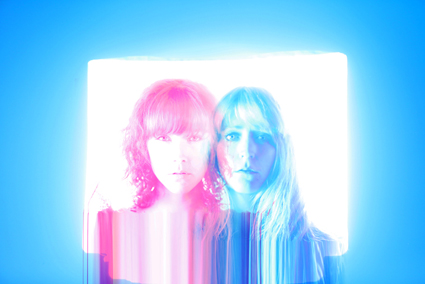
Hedda, This One Show & The Blue Room Theatre
Hedda, This One Show & The Blue Room Theatre
Currently based in Perth, Norwegian actress Marthe Snorresdotter Rovik feels that the current English translations of the Ibsen classic Hedda Gabler are missing something. Actor/director Renato Fabretti and Rovik are producing their own version in which Rovik says she wants to show Hedda as “Ibsen intended. Not a victim, nor an icon for feminist revolt, but a complete woman making a decision about how she will live her life within her circumstances” (press release). Sections of the dialogue will be spoken in Norwegian to convey the emotional intensity of the play’s original language.
This One Show, Hedda, The Blue Room Theatre, 3-31 August; http://blueroom.org.au/
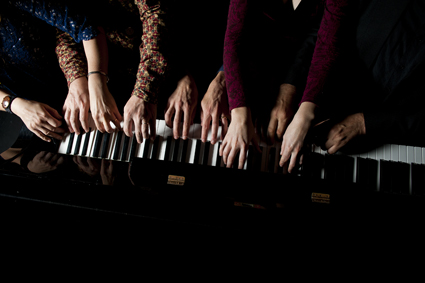
Topology, Ten Hands
courtesy the artists
Topology, Ten Hands
Ten Hands, Topology
Brisbane-based ensemble Topology has just released their 10th album and will be touting their CD wares in a series of not to be missed concert launches in Sydney, Melbourne, Buderim and Brisbane. The album Ten Hands has been collectively composed by the five musicians over the last four years through a process of improvisation and distillation. Violinist Christa Powell says, “When we first got together we were individuals and we’ve spent this many years…getting to know each other. And this piece collectively is an entity” (press release).
Topology Ten Hands Tour: Sydney, Camelot Lounge, Marrickville, 4 August; Melbourne, Chapel Off Chapel, Prahran, 11 August; Brisbane Powerhouse, New Farm, 15 August; Sunshine Coast, Matthew Flinders Performing Arts Centre, Buderim, 1 September; http://www.topologymusic.com/
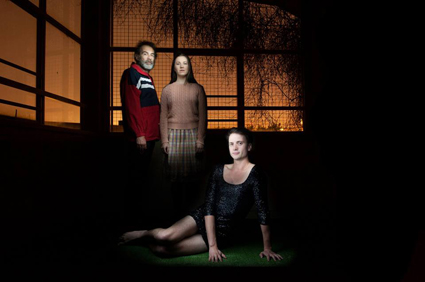
Stuck Pigs Squealing, Night Maybe
photo Sarah Walker
Stuck Pigs Squealing, Night Maybe
Stuck Pigs Squealing, Night Maybe
Melbourne ensemble Stuck Pigs Squealing’s latest project, Night Maybe, follows Sasha, a girl abandoned on the side of the road by her brother. Her search to find him “peels back the layers of their shifting relationship; past the unreliability of gender, sexuality and both their bodies” (website). Directed by Luke Mullins and written by Kit Brookman the collective promise a “free-fall through the subconscious.”
Stuck Pigs Squealing, Night Maybe, TheatreWorks 15 August-1 September; http://www.theatreworks.org.au/whatson/event/?id=182
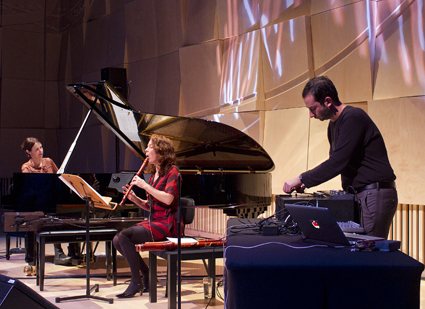
Three Lanes, Andrea Keller, Genevieve Lacey, Joe Talia, Capital Jazz Project
courtesy the artists
Three Lanes, Andrea Keller, Genevieve Lacey, Joe Talia, Capital Jazz Project
Capital Jazz Project, Street Theatre
As part of Canberra 100 celebrations, ANU School of Music and the Street Theatre are presenting the Capital Jazz Project featuring over 90 concerts in 10 days. Intriguing groupings include Three Lanes with Andrea Keller on piano, Genevieve Lacey on recorders and Joe Talia on Revox B77, electronics and percussion (7 Aug); The Tawadros Brothers—Joseph on oud (Aarbic lute), James on raq (Egyptian tambourine)—with Steve Hunter on electric bass (4 Aug); and artists-in-residence, The Raah Project, “investigating cross-pollination between diverse modern music genres” (program) performing with a 20-piece ensemble from the ANU School of Music (10 Aug).
Capital Jazz Project, presented by Canberra 100, Street Theatre and ANU School of Music; 2-11 August; http://www.thestreet.org.au/
![Soda_Jerk, The Phoenix Portal [2005]](https://www.realtime.org.au/wp-content/uploads/art/68/6806_loop_sodajerk_phoenix.jpg)
Soda_Jerk, The Phoenix Portal [2005]
courtesy the artists
Soda_Jerk, The Phoenix Portal [2005]
Dark Matter, Soda Jerk
Movie mash-up mavens Soda Jerk (Dom & Dan Angeloro) have been investigating “the speculative hypothesis that a form of dark matter pervades the star systems of screen culture” (website). This exhibition brings together three of their latest installations in which stars confront their past, present and future selves.
Soda Jerk, Dark Matter, UTS Gallery, 30 July-30 August; http://www.art.uts.edu.au/gallery/current/index.html
Totally Huge New Music Festival
A reminder that the biennial celebration of exploratory music is about to take over Perth, this year also incorporating the International Computer Music Conference. Read RT115 interview with director Tos Mahoney for more details on guests Haco, Alvin Curran, Agostino di Scipio, Speak Percussion, Decibel and Clocked Out. Matthew Lorenzon, who presents the new music blog Partial Durations with RealTime, will be on the ground in Perth reviewing performances for the full duration of the festival as well as mentoring emerging music reviewers.
Tura: Totally Huge New Music Festival; 9-18 August; www.tura.com.au
Ian Potter Cultural Trust 20th Anniversary
The Ian Potter Cultural Trust has given out over 1200 grants in its 20 years of existence. To celebrate the trust is throwing a gala ball and is inviting every one has been a recipient. However IPCT has lost track of some of you. If you’ve received funding from the organiation in the past, check out this link on the website and update your details so IPCT can let you know of all the upcoming celebrations.
http://www.ianpotterculturaltrust.org.au/desperately-seeking
Still in the loop
Janis II, The Commercial Gallery & MCLEMOI Gallery
26 July-17 August
www.thecommercialgallery.com http://mclemoi.com
Owen Wingrave, Sydney Chamber Opera
Carriageworks, 3, 5, 7, 9, 10 August
http://sydneychamberopera.com
Shilpa Gupta, MAAP Space
27 July-30 Aug
www.maap.org.au/
Suburban, Ian Strange
NGV Studio, 27 July-15 September 2013
www.ngv.vic.gov.au
Russian Resurrection Film Festival
Sydney, Chauvel Paddington & Event Cinemas Burwood, 24 July-7 August; Brisbane, Palace Centro, 26 July-4 August, Perth, Cinema Paradiso, 1-11 August; Byron Bay, Palace, 2-4 August
http://russianresurrection.com/
SALA
various venues across South Australia, 2-25 August
http://www.salafestival.com/
NMN:Tangents And Cycle ~440
Sound Lounge, Seymour Centre, 1 August
http://www.seymourcentre.com
Winter, Arts Centre Melbourne
from July 27-18 August
artscentremelbourne.com.au
White Rabbit, Red Rabbit, Malthouse
23 July-3 August
www.malthousetheatre.com.au
Here&Now13, Lawrence Wilson Gallery
27 July-28 September
www.lwgallery.uwa.edu.au; www.dadaa.org.au/
TeleScope: Visions from the EU, online screenings
Melbourne International Film Festival
25 July-11 August
http://miff.com.au/program-categories/telescope
Fraught Outfit, Persona
Belvoir, 24 July-18 Aug
http://belvoir.com.au
Live and Deadly, Carriageworks
27 Jun-1 Aug
http://www.carriageworks.com.au/?page=Event&event=LIVE-AND-DEADLY
My Country, I Still Call Australia Home: Contemporary Art from Black Australia
Queensland Art Gallery/Gallery of Modern Art, 1 June-7 October
http://www.qagoma.qld.gov.au/exhibitions/current/my_country
Helium Season, Malthouse
8 June-5 Oct, see website for following productions
www.malthousetheatre.com.au/helium-2013/
Finucane & Smith’s The Glory Box…Paradise
45 Downstairs, Melbourne, 10 July -11 August
http://www.fortyfivedownstairs.com/events/
RealTime issue #115 June-July 2013 pg.
© RealTime ; for permission to reproduce apply to realtime@realtimearts.net
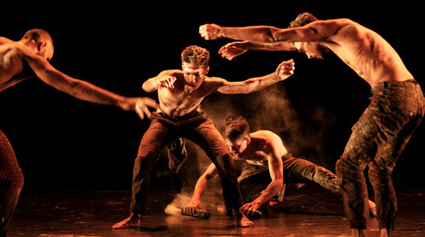
Hunter Page Lochard, Leonard Mickelo, Luke Currie Richardson, Daniel Riley McKinley, Blak, Bangarra
photo Greg Barrett
Hunter Page Lochard, Leonard Mickelo, Luke Currie Richardson, Daniel Riley McKinley, Blak, Bangarra
Choreographically and musically Daniel Riley McKinley takes Bangarra into new realms in Scar, a work focused on young urban Indigenous men who, without access to initiation rites, struggle to emerge into manhood (see the interview with McKinley in RT114).
Held together by a circle of unanimity and their shiny black hoodies the men reveal collective artistry, rising and dipping deep, sliding and stamping against the cry of didjeridu which soon takes on the buzz of a digitised world. The movement, textured with subtly integrated street dance gestures is free of overtly traditional Indigenous steps or Western contemporary dance moves.
A line forms, from which individuals break into athletic leaps and rolls until a siren sounds and the group scatters, like a gang on the run. Amid the breakout of fights and one man wielding a knife against others and then himself (performed with discombobulated brilliance by Waangenga Blanco), the youngest of the men (Hunter Page-Lochard) and the most observant, solos slowly and with great delicacy as if the one most self-conscious of the mysteries of achieving manhood.
Behind the action hangs what appears to be a huge bone, perhaps the traditional scarring tool of initiation denied these young men, but which still hangs over their psyches. An alternative ceremony emerges as the men remove their tops, shape them like weapons and, whiting up their faces and adding their voices to the soundtrack, they circle Page-Lochard, the bone above them now sparkling silver. The incantation of traditional songman Djakapurra Munyarryun soars, clearly spoken in Language, then becoming sung and didjerudi-like against a fast deep bass pulse and percussive techno-layering on a rising scale, the dancing ending as it began, in a circle with escalating energy and confidence, the youngest breaking into his own dance—a symbol of individual maturation in a powerful collective. The supple Page-Lochard excels, his dancing enhanced with additional layers of telling detail.
Paul Mac’s hard-edged score, created with David Page, is an antidote to Page’s broad, often synth-driven hyper-melodic themes. The two composers merge urban and traditional musics into a satisfying and atypical score for Bangarra, true to the challenges facing the men in Scar. If not traditional initiation, Scar at least proposes the importance of some kind of ceremony, physically or psychologically, for a lost rite of passage.
Stephen Page’s Yearning, created with the female dancers of Bangarra, is typically lyrical, cleanly symmetrical, contemporary Western dance infused with traditional shuffling and hopping in the circling and clustering of the earthed first part. Other scenes are more literally dance theatre episodes focused on domestic violence, suicide and constraints on Indigenous identity. In the most strikingly choreographed and staged scene, a TV monitor flickers with white static on one side of the stage while on the other deep yellow light and shadow wrap around three dancers who sink and rise up as if tormented, a voiceover intoning “I feel nothing.” The dancers struggle to support each other. A final angry “No!” leaves the trio immobilised. In the final scene, a radio program asks, “Who is Aboriginal and how can they be identified?” The dancers in line hang their heads low and move with sinuous angularity, their collective centre of gravity lowering until they sit, looking out at us. Surtitles for the recorded passages of Language and Aboriginal English were not provided, making some of the critical situations faced by the women quite unclear.
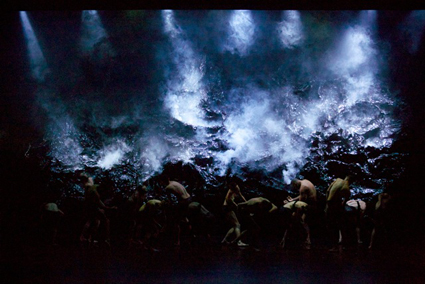
Blak, Bangarra
photo Greg Barrett
Blak, Bangarra
Keepers, the third work in Blak, a joint creation by Page and McKinley for the whole company, benefits from a magnificent set design, a vast rocky wall before which, in an overarching sense of ceremony, the dancers tuck into themselves, unfold and display their dancing prowess. The rock face glows and smokes, suggesting the primal power of the land, pulling the swaying dancers to it, its presence amplified by the sound of ‘ancient’ voices and a pulsing beat (Page with Mac). The dance becomes celebratory with heterosexual pairings creating images suggestive of procreative power. With a glance back to Scar, Lochard-Page cuts a singular figure in this adult world. Finally the steaming rock and the exhilarated dancers are cooled by cascading rain—a waterfall of well-being.
Once again, Jacob Nash proves himself to be a truly inventive designer, complemented by Luke Ede’s spare costuming and Matt Cox’s acute play with light. Blak, a popular and critical success for Bangarra, signals a tension between a Bangarra style that has not substantially progressed in recent years and indications of new possibilities—in McKinley’s more contemporary dance vocabulary, in moments in Page’s Yearning, and in the music for Scar.
Bangarra Dance Theatre, Blak, Drama Theatre, Sydney Opera House, 7-29 June
RealTime issue #115 June-July 2013 pg. web
© Keith Gallasch; for permission to reproduce apply to realtime@realtimearts.net
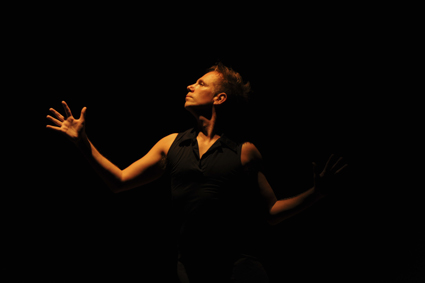
Martin del Amo, The Little Black Dress Suite
photo Heidrun Löhr
Martin del Amo, The Little Black Dress Suite
The ‘black dress’ is unparalleled in its iconic status as elegant, timeless, classic. One need only think of Audrey Hepburn in Breakfast at Tiffany’s to understand this powerful feminine symbol that shuttles between sexy and demure. So what is choreographer Martin del Amo doing with this fashion archetype in his direction of the four solos in The Little Black Dress Suite?
The threads are historical and cumulative. Del Amo attests that the little black dress emerged intuitively as a costume in three earlier works in very different contexts. It’s a potent, recurring element “reimagined” in this new suite of works through juxtaposition and gender disruption.
Each solo and instance of the little black dress varies in duration and musical accompaniment—noting grammatically that definite article ‘the’ refers to the single form/idea and not the use of one garment. One ‘dress’ is worn by Miranda Wheen in a collaboration with composer and musician Alex Pozniak. This relationship was established in 2012 under the direction of del Amo for Synchronicity, a co-production between Dirty Feet and Chronology Arts (see RT109). In redux, Wheen will again precariously “negotiate an imaginary environment of invisible forces” on high heels (another Del Amo symbol) in a tight, little black dress—the physical reality of her movement pushing against, yet tightening the image. In this tensile elaboration we can only ask: “is she appropriately dressed?”
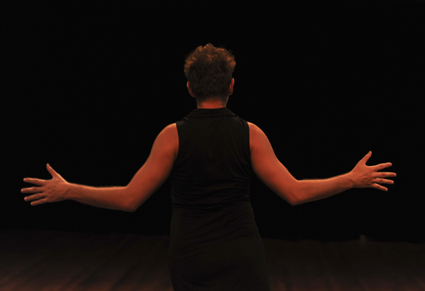
Martin del Amo, The Little Black Dress Suite
photo Heidrun Löhr
Martin del Amo, The Little Black Dress Suite
A second dress, worn by del Amo himself, was unleashed in all its Bob Fosse glory at Campbelltown Arts Centre in 2010. What Good is Sitting Alone in your Room was a tribute to the Master of Jazz. An incompatible aesthetic equation—del Amo and Fosse—but one balanced through likened compositional strategies (ie isolation of body parts). Del Amo in a cocktail dress is no transvestite. Dancing del Amo dissociates ideas of the feminine from the frock and his embodiment in order to make new.
Kristina Chan wears a third dress, more in the style of Wheen’s—tight and short. This will be a new solo, something along the lines of Jane McKernan’s powerful downstage finale from Slow Dances for Fast Times (2013, see RT114). Surprisingly this is the first time del Amo has choreographed Chan in a piece and ideally not the last.
Sue Healey presents a fourth and final dress, described by del Amo as “worn in the vein of the sassy.” Developed from scratch, this work consciously starts with the dress and is informed by its final position in the suite. Long-time chorographer Healey has recently appeared as a dancer on Sydney stages, including in a duet with del Amo for the IOU Dance 2 season at UNSW. Together they have been developing a regular studio practice, born from one of del Amo’s famous performative birthday presents to dancers.
The dresses connect the solos through a stylistic and symbolic unity. Each is moved, extended and worn differently. From this coherency of eclecticism (also a del Amo trademark) individual meanings can be massaged. Musically we can expect something similar, with compositions by Alex Pozniak (with Wheen) and Gail Priest (with del Amo), whose original pieces will be placed next to an operatic aria from Mozart (for Chan). Healey’s music co-conspirator (be they dead or alive) will be revealed on the night.
The solo is a fragile and difficult mode of performance. We demand of the solo performer an attention without slack; anyone who has seen del Amo perform will attest to very little slack. This acuity of attention can be seen in the several solos he has made on others: Miranda Wheen, Paul White and the 12 dancers in Slow Dances for Fast Times.
Del Amo speaks of “schizophrenic roles” inherent in creating solo performance work. Simultaneously performer, director, dramaturg and choreographer, he battles many voices that sometimes agree, sometimes don’t. When he choreographs others in a solo, it is not a ‘del Amo possession’ we see, but the transmission of his choreographic thinking—a subtle phenomenon not always transparent to an audience. The compositional strategies and organisation of the body are migratory structures that del Amo generously shares in workshops and the rehearsal room. The dancer moves within set parameters and scores, generating material as a unique product of their attention. It is the appearance of these structures across the many solos that marks the dancer with del Amo’s signature, the mobility of his thinking from one solo to the next—elegant, timeless, classic.
Form Dance Projects: The Little Black Dress Suite, choreographer Martin del Amo, performers Martin del Amo, Miranda Wheen, Kristina Chan, Sue Healey; composers Alex Pozniak, Gail Priest, Mozart, Lennox Theatre, Riverside, Parramatta, 15-17 August; http://form.org.au/2013/01/the-little-black-dress-suite/
RealTime issue #115 June-July 2013 pg. web
© Jodie McNeilly; for permission to reproduce apply to realtime@realtimearts.net
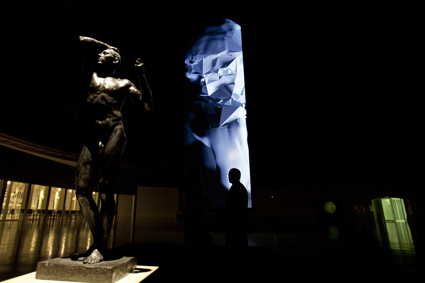
Davide Quayola, Matter, Sónar 2013
photo Consuelo Bautista
Davide Quayola, Matter, Sónar 2013
Sónar forced me, for the sake of integrity, to smuggle Cointreau in my underpants. But I’ll get to my rationalisation for that in a moment. First, let me tell you about some genuinely lovely things that were presented in Barcelona as part of Sónar this year.
I’ve not seen anything more grandly presented than Davide Quayola’s Matter, as viewed at sunset. I ascended to the marvelously overstated domes of Catalunya National Museum of Art via four flights of Olympic-grade stairs, past the Font Màgica and sculpted formal gardens. I was then ushered past curtained and closed galleries into a colossal, tiered, domed and nearly empty hall where a 12-metre projection screen hung with a Rodin bronze in front. Name notwithstanding, Matter is an essay in pure form: the subject is a digital recomposition of Rodin’s Thinker, skewed by staccato glitches and mutations, stripped back to skeletal polygons. A soundtrack of similarly glitched harmonies by Matthias Kispert invites quiet contemplation of this digital excoriation of form. What is the minimal number of bits needed to evoke the classic Rodin work? It’s not far from that fashionable lo-fi video mangling technique “datamoshing,” but this one is strictly for the Blu-ray set. With this much build-up for a work, nothing but a 12-metre screen will do. I mean, eleven-and-a-half won’t cut it when there are two separate thronging break-dancing competitions outside. In scale and contrast alone, this simple work has a mammoth effect.
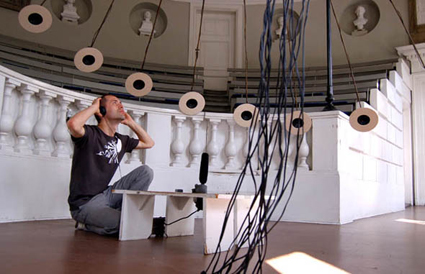
Jacob Kierkegaard, Labyrinthitis, Sónar 2013
courtesy CosmoCaixa
Jacob Kierkegaard, Labyrinthitis, Sónar 2013
In contraposition, presented subtly to the point of subliminality, Jacob Kierkegaard’s auditory installation lurks amongst the chaos of CosmoCaixa, the children’s science museum. A visual pun on the cochlear shape of the museum’s central ramp, Labyrinthitis is made of nothing but speakers. Each plays intra-aurally recorded “Tartini tones”—pure tones eliciting illusory psychoacoustic ghost tones. The concept is neat, a confusing blurring of reality at the edges of perception as you walk through the stylised inner ear. Then you emerge into the museum’s trilobite display and that piece is over.
For both these offsite Sónar works a highlight is their apposite placement amid this extravagant and personable city. But even Barcelona has bleak concrete sheds to wall out the cityscape for banal corporate events and the like, and this leads me to Sónar’s onsite art, which is where things fall apart.
First of all, there’s not much of it. Despite a floor crammed with notionally-creative-technology companies’ newest product demonstrations, there is not much actual, well, art; certainly not “art” in the sense that one might go to a festival to experience—say, stuff that didn’t come out as a smartphone app for $0.99 last year.
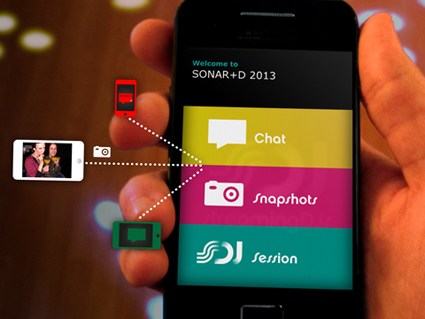
Sónar 2013 Streaming DJs APP
Take the much-press-released Skrillex Variations by Robert Sakrowski, which is a YouTube playlist of cover versions of Skrillex’s song “Scary Monsters & Nice Sprites.” The text for the piece claims that it “reflects on the paradigm shift in consumerism through YouTube, where artist fans (sic) no longer behave as mere spectators or consumers but are rather actively involved in transforming the methods and material of their idols.” It’s a brave fool who examines consumer interaction by framing a passive YouTube mashup thus, in this venue. Whatever else I might say about them, the main things these market stallholders are selling are tools to actually interact with and remix the hell out of media and the Skrillex Variations looks especially perfunctory by comparison.
But there is an even less flattering comparison, just down the metro line, and definitely not part of Sónar: the large and top notch video-art exhibition This is not a love song at the La Virreina Image Centre, showcasing more permutations and perversions of the music video than are dreamt of here, in a thoughtful and lovingly curated show with a minute fraction of the budget of the festival. To drive the knife home: it’s free admission.
Let’s talk about this inward-looking tendency at Sónar in light of its obtrusively interesting surroundings. This is a country rocked by unrest. There is a 57% youth unemployment rate and rolling corruption scandals in a region with an upcoming secession referendum. Oh and by the way there are still aftershocks from Europe’s freshest and longest dictatorship and yet the festival is politics-free. Then, in a city whose unique tapestry is threaded with architectural innovation old and new, Sónar opts for generic exhibition halls.
Outside are street protests, scandal, corruption, anti-capitalism, fascist revivalism, catholic fundamentalism. Outside there are cathedrals, boulevards and buskers, beer-drinking families watching skate-offs, grandmothers toasting the sunset in pleated skirts and a skyline marked by an intergenerational cadre of revolutionary architects. Inside, there are concrete walls and the eternal bar queue, and this most idiosyncratic of cities is made as bland as an airport lounge. There is nothing to startle the privileged customer base out of their global party with the hint of local flavour. I’m not demanding all my art be ‘site-specific’ but to turn such a fertile site into something so sterile is plain perverse.
But fine, we can ignore the suggestive locale in favour of bringing the best the world has to offer, thanks to the global reach and brand-power of this renowned festival. Right? Except Sónar’s curatorial hand, it seems, has been supplanted by UK video producer Adam Smith’s invisible hand. This is one of the most outrageously successful festivals on the planet to have “new media art” in its name. One hundred and twenty one thousand punters passed into the maw of this monster, putting its budget somewhere in the double-digit millions before sponsorship. Yet the content of the actual new media art program in no way reflects that. The echoing conference halls that Sónar has occupied are mostly filled with banners from the booze sponsor and for-cash booths for various start-up companies offering modestly interesting software for driving techno with your iPad.
Missing: commissions, experiments, thrills. There are some promising student semester works from the local university. There are some momentary events here and there like the laptop jam in a mostly-unused cinema. That’s it, really. Mostly, the few works are okay, but the curation is… well… It is as if, a week before raising the curtain, someone noticed the words on the flyer, and decided it would be cheaper to commission a half-dozen unrelated works to tick that box than to reprint the promo material. You know, as long as it doesn’t get in the way of the festival-run-monopoly beer-tent. And by the way, please pat-search everyone at the gate while checking their two hundred euro tickets. And THAT is why, even as the gate security drain one friend’s water bottle and confiscate another’s contraband apple at the gate, I skive in on a press pass with my trousers stuffed with illicit citrus liqueur.
But enough. This is sufficient bile, or nearly so. For though the program is perfunctory as compared with the hype, there are one or two events on the closing night that are worth mentioning. For one, who can fail to love Max Richter’s reboot of the Vivaldi franchise, performed live? Four Seasons recomposed has no enemies. As lounge-room-loveable as the original but so much more hip; seeing it with real live violins right there really takes the sting out of the Naxos guilt.
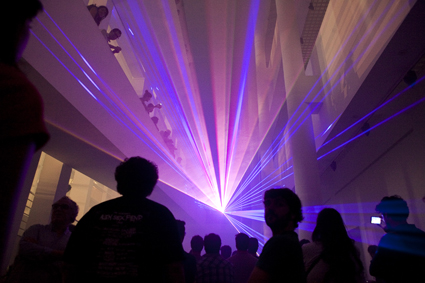
Lorenzo Senni, ORACLE, Sónar 2013
Photo Oscar Garcia
Lorenzo Senni, ORACLE, Sónar 2013
Directly after, in the contemporary art museum and former Sónar venue MACBA, producer Lorenzo Senni performs ORACLE, slicing up fragments of rave music samples into arpeggiated Reichian loops. But wait, here’s the grabber: this guy has a colour laser and a smoke machine. Oh, alright, I could be fairer to the artist than that trite statement, because the effect is impressive. In the museum, the elongated lasers carve the imposing volume of the atrium into a kind of luminous architecture. In this context, though, it’s not the most propitious choice for a closing act. Senni has taken a vibrant, politicised artistic form, abstracted it and removed its context and content in favour of pure structure. It’s soothing, of course. But if it’s a Sónar commission, I recommend they reconsider their brief, because the analogy it presents with their current state is unfortunate. The endless, charming, pointedly vacuous ornamentation mirrors the overall curatorial direction of Sónar itself: pretty, safe, emptied of message.
Sónar, 20th International Festival of Advanced Music and New Media Art, Barcelona, 12-16 June 2013; http://www.sonar.es/en/2013/
This is not a love song, curator F. Javier Panera, La Virreina Centre De la Image, 22 May- 29 September 2013; http://lavirreina.bcn.cat/en/exhibitions/not-love-song
RealTime issue #115 June-July 2013 pg. web
© Dan MacKinlay; for permission to reproduce apply to realtime@realtimearts.net
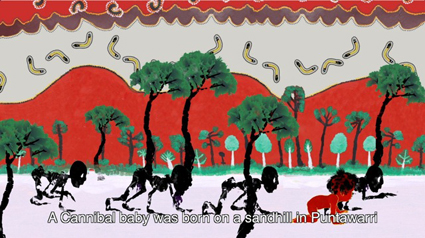
Yunkurra Billy Atkins & Sohan Ariel Hayes, Cannibal Story
Naala-Ba, curated by ISEA Indigenous Creative Producer Merindah Donnelly, was a brisk, enjoyable and thoughtful contribution to the ISEA2013 program, if providing little evidence of or information about the much wider Aboriginal and Torres Strait Islander engagement with electronic media.
Yunkurra Billy Atkins & Sohan Ariel Hayes, Cannibal Story
Martu (Western Desert, Pilbara region) artist, lawman and storyteller Yunkurra Billy Atkins collaborated with Perth-based media artist Sohan Ariel Hayes to create an engrossing animation that tells an alarming traditional tale of skeletal earth spirits, the Cannibals of the film’s title and how they savaged Atkins’ Dream Time ancestors living around Lake Disappointment (“white fella name my country”).
Atkins’ unfolding landscape is bordered with slithering snakes is realised in solid colours heightened with dots. When the black-skulled Cannibals emerge, they rush towards us, appearing to break through the thickly painted two-dimensional plane, but without spoiling the integrity of the artist’s inheritance and adaptation of traditional painting. You can see a very brief example of this on Vimeo.
The birth of a greedy baby Cannibal, quite human in appearance, signals disaster for the pale-skinned, big-jawed Martu. The Cannibals attack, striking off heads and limbs and emptying bodies into the salt lake into which the Martu, bound to be eaten, slowly sink amid mud and bones. As for the Cannibals, “They alive, not dead…,” says the storyteller at the solemn end of this skilfully animated, lively and visually accomplished seven-minute film.
Naretha Williams, Shifter
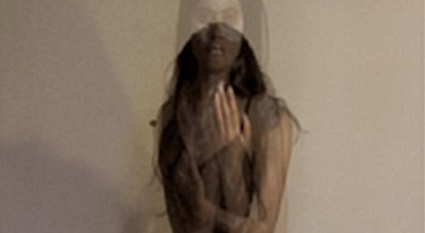
Naretha Williams, Shifter
At the end of long dark curtained passageway, projected at almost human scale on a vertical screen, is the image of a young woman, head down, standing amid small candles. She looks up at us with a direct gaze, almost defiant, her body moving in a minimal, gestural dance over which a super-imposed self slowly appears, ghost-like, hands hovering over a face marked in white as if for a ceremony. As in many Aboriginal works, contemporary or traditional, the sense of an ever-present spiritual dimension is near palpable.
The maker and performer of Shifter is Melbourne-based Wiradjuri artist Naretha Williams—described in the program note as “creat[ing] work that explores, questions, provokes and dismantles ideas around identity, culture, esoteric knowledge and contemporary shamanics.” She has a very evident interest in co-existing selves, “shifting and morphing, yet holding the same space”—hence the title of this 3.50-minute video loop.
Gordon Hookey, Terraist
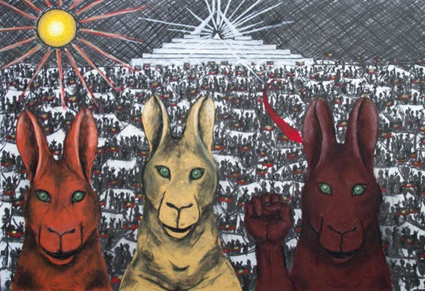
Gordon Hookey, Terraist
With the title Terraist, Brisbane-based, Waaynyi (Southern Gulf of Carpentaria) artist Gordon Hookey converts “Terra Nullius” into a provocative act of reclamation, at the same time reappropriating the kangaroo as a symbol from White Australia in his funny but pointedly political animated film.
Line drawn animation briskly sketches a tent city over which Canberra’s Parliament House forms and people mass about the tents. They are revealed to be kangaroos (Hookey’s favoured image of resistance), three of them forming before us in close up, defiant, fists raised, their fur filling with colour (ochre-ish red, yellow, brown). Acquiring sunglasses they appear stylishly authoritative as well as tough, their eyes taking on the hues and shape of the Aboriginal flag. It’s as if their very being, a source of great energy and luminescence, is enough to change the world in a mere 1:53 minutes.
You can watch Terraist here and then let Gordon Hookey take you on a guided tour of the work here.
Naala-Ba
Naala-Ba, a program note tells us, means ‘look to the future’ in the technically extinct Dharug language, although specific words have been collected and adapted (http://www.dharug.dalang.com.au). The exhibition displays works that are potent in their own right, if not exemplary of the range of strengths of Indigenous artists’ engagement with electronic media.
In an ISEA program that looked back to electronic art’s past as well as celebrating its present, it’s a great pity that digital works by Rea, Karen Casey, Warwick Thornton (as with his 3D installation, Stranded in 2011 and Mother Courage at ACMI this year http://www.realtimearts.net/article/issue113/10963) and others were not exhibited. Instead two animations and a video work comprised Naala-Ba and Christian Thompson, with a haunting sound work (the winning entry for me), was a finalist in the video-dominated Anne Landa Award for video and new media arts exhibition at AGNSW.
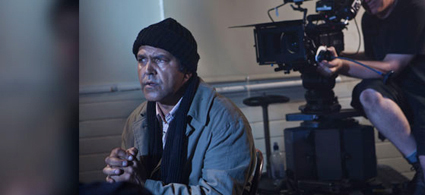
Rose Tatoo, Alanna Rose (funded by Metro Screen)
Metro Screen: Indigenous programs & Storyworld Seminar
This free information session for Indigenous people interested in working in film and television will introduce a variety of programs including free short courses in digital, TV, and film skills, scholarships and funding opportunities. Metro Screen is also presenting the Storyworld Seminar, a panel discussion around the development and production of interactive multiplatform stories. There’s a range of other information sessions and panels too on offer over August.
Are You Indigenous And Want To Work In Film And TV? information session, 6 August; Story World Seminar, 9 August; http://metroscreen.org.au/7-events-opportunities-you-dont-want-to-miss/
2high Festival 2013 Artist Call Out
Backbone Youth Arts is now calling for applications from emerging artists around Australia to participate in the annual 2high Festival. The festival is programmed and run by 12 emerging artists and will take over Brisbane Powerhouse on 2 Nov.
Applications close 16 August; http://www.backbone.org.au/2high-festival.cfm
Still in the loop
France 24 – Rfi Web Documentary Visa D’or Award 2013
Entry deadline 26 July, 2013
http://www.france24.com/en/webdocumentary-award-2013
2013 INSITE Award
Deadline 26 July
www.awg.com.au
Abbotsford Convent, Spiritous 2014
Applications due 29 July 2013
http://www.abbotsfordconvent.com.au/venues-hire/cultural-programming
Bundanon Artist Residencies
Applications close 2 August
www.bundanon.com.au/content/residencies
PauseFest
Registration and final design submission August 15
http://pausefest.com.au/download_docs/pausefest2014_eoi_details.pdf
Tele Visions, call for screen works
Applications close 29 August
http://televisionsproject.org/
Australia Council upcoming deadlines
(for full list see http://www.australiacouncil.gov.au/grants)
Hopscotch, 19 July 2013
(for Market Development; National Touring, International touring)
http://www.australiacouncil.gov.au/grants/2013/hopscotch
Music: International Pathways – Round 4, 22 July 2013
http://www.australiacouncil.gov.au/grants/2013/music-international-pathways-22-july
Music: Peggy Glanville-Hicks Residency, 22 July 2013
http://www.australiacouncil.gov.au/grants/2013/peggy-glanville-hicks-residency
Emerging and Experimental Arts: Creative Australia – New (Art Creative Development), 01 August 2013
http://www.australiacouncil.gov.au/grants/2013/inter-arts-creative-australia-new-art-creative-development
Theatre: Cultural Leadership Skills Development, 5 August 2013
http://www.australiacouncil.gov.au/grants/2013/cultural-leadership-skills-development-theatre
Theatre: New Work, 5 August 2013
http://www.australiacouncil.gov.au/grants/2013/theatre-new-work
Theatre: Fellowships, 5 August 2013
http://www.australiacouncil.gov.au/grants/2013/theatre-fellowships
Creative Australia – Emerging Presenter, 12 August 2013
http://www.australiacouncil.gov.au/grants/2013/Creative-Australia-Emerging-Presenter
Creative Australia – New Digital Theatre, 12 August 2013
http://www.australiacouncil.gov.au/grants/2013/Creative-Australia-New-Digital-Theatre
International Markets – Music managers (Previously Live On Stage – Music Managers). 14 August 2013
http://www.australiacouncil.gov.au/grants/2013/international-markets2-music-managers-14-aug-2014
Dance: Artform Development, 16 August 2013
http://www.australiacouncil.gov.au/grants/2013/dance-artform-development
Dance: Fellowships, 16 August 2013
http://www.australiacouncil.gov.au/grants/2013/dance-fellowships
Dance: Projects – Creative Development, 16 August 2013
http://www.australiacouncil.gov.au/grants/2013/dance-projects-creative-development-16-august
Dance: Projects – Presentation, 16 August 2013 http://www.australiacouncil.gov.au/grants/2013/dance-projects-presentation-16-august
Dance: Creative Australia – New Work, 16 August 2013
http://www.australiacouncil.gov.au/grants/2013/dance-creative-australia-new-work
Visual Arts: Skills and Arts Development – Residencies, 19 August 2013
http://www.australiacouncil.gov.au/grants/2013/visual-arts-skills-and-arts-development-residencies
Visual Arts: Presentation and Promotion, 21 August 2013,
http://www.australiacouncil.gov.au/grants/2013/visual-arts-presentation-and-promotion
Visual Arts: Skills and Arts Development – General, 21 August 2013
http://www.australiacouncil.gov.au/grants/2013/visual-arts-skills-and-arts-development-general
RealTime issue #115 June-July 2013 pg. web
© RealTime ; for permission to reproduce apply to realtime@realtimearts.net
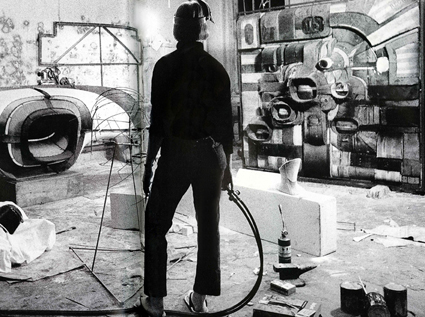
Lee Bontecou in studio 1963
photo Ugo Mulas, courtesy The Commercial Gallery and MCLEMOI Gallery, Sydney
Lee Bontecou in studio 1963
Janis II, The Commercial & MCLEMOI Galleries
Janis encompasses a range of activities initiated by Kelly Doley (a member of Brown Council) focusing on female artists, writers and thinkers allowing them “to be heard a little louder, to take up more space and more time in the world” (website). She has teamed up with Amanda Rowell to curate the second Janis exhibition spanning two Sydney inner city galleries, The Commercial and MCLEMOI. Janis II features abstract, conceptual and minimalist work by Bonita Bub, Jenny Christmann, Sarah Goffman, Gail Hastings and Sarah Rodigari (who will be performing at the opening, 26 July). A publication featuring short pieces by an impressive list of female artists and thinkers will also accompany the exhibition. (For the amusing significance of the Lee Bontecou image read Gail Hastings’ insightful essay Thank goodness Donald Judd wasn’t a misogynist.)
Janis II, The Commercial Gallery & MCLEMOI Gallery, 26 July-17 August; www.thecommercialgallery.com http://mclemoi.com
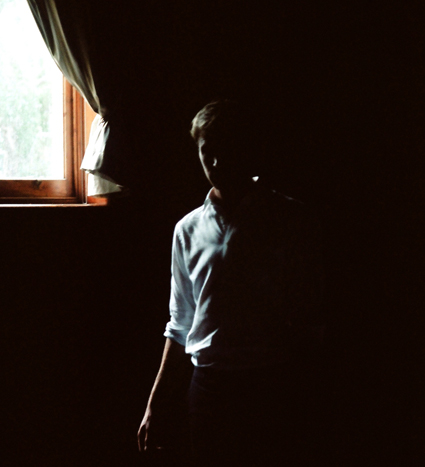
Sydney Chamber Opera, Owen Wingrave
photo Samuel Hodge
Sydney Chamber Opera, Owen Wingrave
Owen Wingrave, Sydney Chamber Opera
An interesting development in Sydney’s contemporary classical musical landscape has been the rapid rise of Sydney Chamber Opera under the leadership of Louis Garrick and Jack Symonds. The company has continued to impress with what Keith Galllasch described as “strong programming, quality musicianship, brave directors and very strong design” (RT113). Their next production is Benjamin Britten’s Owen Wingrave (1967), exploring familial bonds, war and pacifism. Directed by Imara Savage it presents an interesting challenge as the opera, based on a story by Henry James, was originally commissioned by the BBC as a work for television.
Owen Wingrave, Sydney Chamber Opera, Carriageworks, 3, 5, 7, 9, 10 August; http://sydneychamberopera.com
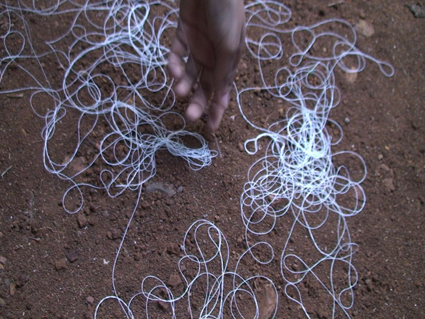
Shilpa Gupta, Untitled, video still, 2012
Shilpa Gupta, MAAP Space
Indian artist Shilpa Gupta has garnered attention on the international media art scene since the late 90s with her intelligent blending of politics, social commentary and playfulness. Gupta will be exhibiting four works at MAAP Space in Brisbane—two single channel video pieces, an interactive sound installation and an embroidered wall hanging—continuing her conceptual interrogation of borders and nationality.
Shilpa Gupta, MAAP Space, 27 July-30 Aug; www.maap.org.au/
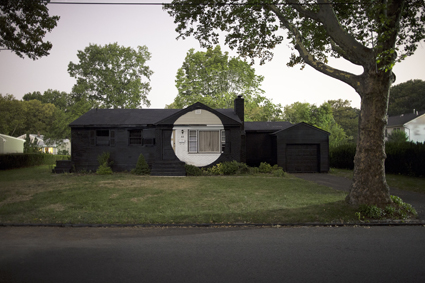
Ian Strange, Corinne Terrace 2011 archival digital print
collection of the artist, New York © Ian Strange
Ian Strange, Corinne Terrace 2011 archival digital print
Suburban, Ian Strange, NGV
Perth street artist Ian Strange now lives mostly in New York and is becoming world renowned for his ambitious projects. In Suburban, Strange travelled around America—Ohio, Detroit, Alabama, New Jersey, New York and New Hampshire—painting directly onto houses that were slated for demolition. The actions, which even included burning down a property, have been documented and will form the basis of a multichannel video installation, accompanied by large format prints and relics from the houses themselves.
Suburban, Ian Strange, NGV Studio, 27 July-15 September 2013; www.ngv.vic.gov.au
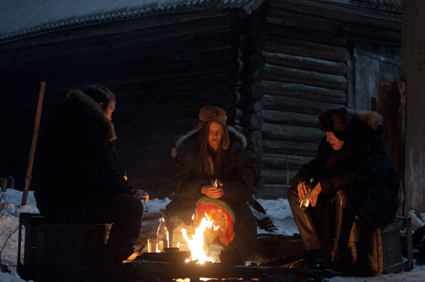
Me too, Alexei Balabanov
Russian Resurrection Film Festival
It’s the 10th anniversary of the Russian Resurrection Film Festival and while it has already played Melbourne and Canberra, the Sydney, Perth, Brisbane and Byron Bay iterations are still to come. Possible highlights: Me too (2012) by controversial director Alexei Balabanov (recently deceased), a contemporary Tarkovsky-inspired search for happiness in a no-go zone; the road movie Artefact (2010), a debut feature by actor Andrey Sokolov; the brutally honest documentary Anton’s right here (2012), following the life of a young man with mental illness, directed by Lyubov Arkus; and the 1966 comedy Beware of the Automobile, Eldar Ryazanov’s take on a Soviet Robin Hood.
Russian Resurrection Film Festival, Sydney, Chauvel Paddington & Event Cinemas Burwood, 24 July-7 August; Brisbane, Palace Centro, 26 July-4 August, Perth, Cinema Paradiso, 1-11 August; Byron Bay, Palace, 2-4 August; http://russianresurrection.com/
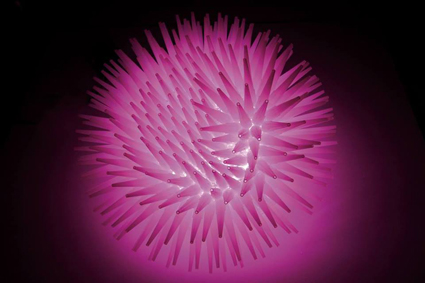
Jemimah Davis, Silicone Nozzles (2013, installation detail), nozzles, Tupperware, LED lights
South Australian Living Artists (SALA)
Every August, South Australia celebrates its living artists. This year there are 4,917 artists involved ranging from amateur to emerging to established with over 500 exhibitions on offer. Highlights include Crystal Palace at Flinders University City Gallery which places the work of nine contemporary artists ‘in conversation’ with objects from South Australian museums and archives” (website). Emerging artist Jemimah Davis takes ordinary objects and transforms them into magical glowing ones in Fluorescence at Urban Cow Gallery. Outside of Adelaide on the Fleurieu Peninsula you can catch Where are you? What time is it? How do you know? by Margaret Worth at Signal Point Gallery working with projection group Illuminart and sound artist Tom Harrer to play with the viewer’s image, seemingly shifting it through time and space.
SALA, various venues across South Australia, 2-25 August; http://www.salafestival.com/
Tangents And Cycle ~440, Sound Lounge
The New Music Network presents an evening of exploratory electro-acoustic music with two relatively new ensembles, Tangents and Cyle ~440. Tangents is a kind of super group including Ollie Bown (Icarus), Shoeb Ahmad and Evan Dorrian (Spartak), Andrian Klumpes (Triosk) and Peter Hollo (Four Play), playing a kind of “post-everything mesh of styles” (website). Cycle ~440 is a duo from Perth featuring RealTime writer Sam Gillies on laptop and Kevin Pen on piano performing semi-improvised settings from their soon to be released album The Topography of Ascending Structures.
New Music Network presents Tangents And Cycle ~440, Sound Lounge, Seymour Centre, 1 August; http://www.seymourcentre.com
Still in the loop
Winter, Arts Centre Melbourne
from July 27-18 August
artscentremelbourne.com.au
White Rabbit, Red Rabbit, Malthouse
23 July-3 August
www.malthousetheatre.com.au
Hello, Becky Hilton & Producciones La lagrima
1000 £ Bend, Melbourne, 23-25 July
www.helloprojectmelbourne.com/
Here&Now13, Lawrence Wilson Gallery
27 July-28 September
www.lwgallery.uwa.edu.au; www.dadaa.org.au/
Home 3, Olaf Breuning
Institute of Modern Art, Brisbane
8 June-27 July
www.ima.org.au/pages/exhibitions.php
Queensland Music Festival
Various venues, QLD, 12-28 July
www.qmf.org.au
TeleScope: Visions from the EU, online screenings
Melbourne International Film Festival
25 July-11 August
http://miff.com.au/program-categories/telescope
Intra-action: Multispecies becomings in the Anthropocene
MOP Gallery, 11-28 July
http://intraactionart.com/
Fraught Outfit, Persona
Belvoir, 24 July-18 Aug
http://belvoir.com.au
Live and Deadly, Carriageworks
27 Jun-1 Aug
http://www.carriageworks.com.au/?page=Event&event=LIVE-AND-DEADLY
My Country, I Still Call Australia Home: Contemporary Art from Black Australia
Queensland Art Gallery/Gallery of Modern Art, 1 June-7 October
http://www.qagoma.qld.gov.au/exhibitions/current/my_country
Helium Season, Malthouse
8 June-5 Oct, see website for following productions
www.malthousetheatre.com.au/helium-2013/
Finucane & Smith’s The Glory Box…Paradise
45 Downstairs, Melbourne, 10 July -11 August
http://www.fortyfivedownstairs.com/events/
Anne Ferran, Box of Birds
Stills Gallery, Sydney; 26 June to 27 July 2013
www.stillsgallery.com.au
Vocal Folds, Gertrude Contemporary
21 June-20 July; performances 11 July, 18 July
www.gertrude.org.au/exhibitions
RealTime issue #115 June-July 2013 pg. web
© RealTime ; for permission to reproduce apply to realtime@realtimearts.net
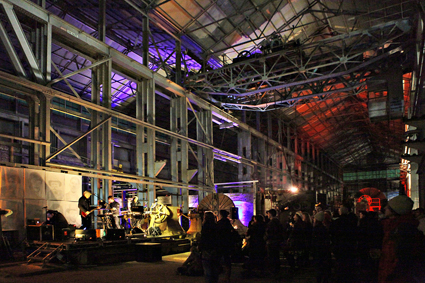
Underbelly 2011, Turbine Hall
photo Prudence Upton
Underbelly 2011, Turbine Hall
Underbelly (the arts festival not the television empire) was founded by Imogen Semmler in 2007 with the intention of bringing to the light underground creative activities that were going on in dark warehouses and shady loungerooms around Sydney (see interview RT103). The first event was a shoestring affair developed in partnership with the then newly opened Carriageworks (RT80). After a second year there the event moved to the streets of Chippendale and then the fourth iteration, in 2011, took over Cockatoo Island.
The last event was so successful it sold out, bringing 2,200 people across the harbour on a glorious winter’s day to take in experimental and emerging art nestled among the skeletons of heavy industry (RT104). With this success under her belt, Semmler decided that it was a good time to pass the baton and so the 2013 festival is headed by Eliza Sarlos as Artistic Director with Jain Moralee as Executive Director. (Sarlos has been incubating more than the festival program over the last nine months, so will in fact be on maternity leave as the event actually takes place.)
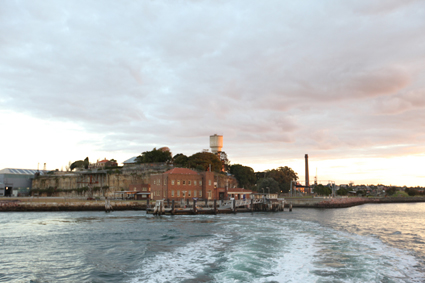
Cockatoo Island
photo Catherine McElhone
Cockatoo Island
What sets Underbelly apart from other festivals for emerging artists is its focus on creative development. Built into the structure of the event from its inception has been an intensive lab (two to three weeks) in which the artists research and develop their work onsite, granting the public daily access to the process. The lab culminates in the festival day, expanded this year to two days, in which the close-to-final products are shown. Sarlos says of this change, “Obviously it’s more of an investment but ultimately one of the aims of Underbelly Arts is to introduce new audiences to work we think is great from the next generation of artists. After selling out in 2011, going to two days really made sense for us. It was an opportunity to grow the festival—to continue that trajectory of growth that had been established by Imogen.”
Sarlos came on board in 2012 with a background in a range of activities: Executive Director of Music NSW; co-director of Sound Summit one of the then This Is Not Art Festivals; radio broadcaster on both 2SER and FBi (at the latter introducing the first talk-based program); and manager of various alternative bands. When she was invited to apply for the Underbelly position she realised that she’d “never taken pause to reflect and see how the very different things that I’d been involved in all had that one same link—working with artists to make things that I think are pretty incredible happen.”
I asked how she has approached being the first director after the founding mother had moved on. “Imogen had done such an amazing job at building Underbelly that there was so much I didn’t want to change at all. Although it had grown organically at every step of the way I felt like it had been a really considered process.” The main shift Sarlos has introduced is to give artists more preparation time by introducing earlier application rounds. “I think the process of doing that this year means that those artists have had maybe seven or eight months [preparation]. I think for 2015 we’ll try and do that even earlier. It’s worked really well. It has a lot of potential in growing what the works can be and making it easier to realise really ambitious ideas.”
The 2013 program really does offer very large scale dreaming with 30 projects by over 100 artists, many of them quite new names to the art scene. Sarlos refused to play favourites so here’s my sampling.
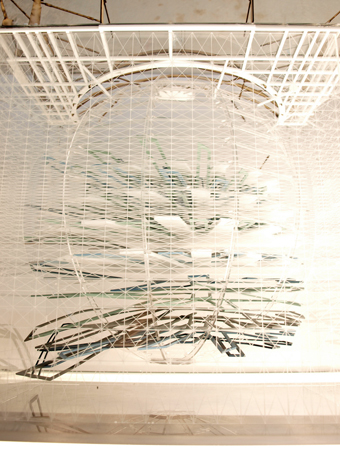
My Nourooz, Kink Studio
Mammoth: The Anti-Artifact Project will hopefully live up to its name as a team of young architects, The Lot, use Cockatoo Island’s graveyard of old machines as a creative playground in an “open-source conversation about urban decline and architectural mystery” (website). Taking a completely opposite approach, the young designers of Kink Studio will use their state-of-the-art fabrication technology to build clean geometric shapes that will be suspended in their work, titled My Nourooz, in one of the mammoth warehouses The collaborative team Ess.E.Kai will be picking up everyone else’s refuse created during the lab to make Assemblage, a kind of archive of discarded creativity.
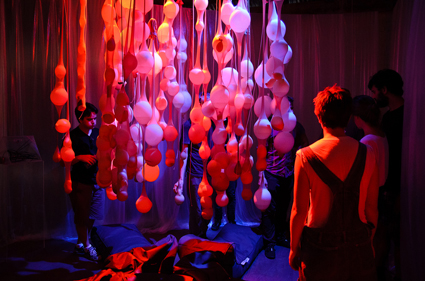
I Met You In A City That Isn’t On The Map, We Do Not Unhappen
photo Lucy Parakhina
I Met You In A City That Isn’t On The Map, We Do Not Unhappen
On the performance front, Nick Keys, writer and raconteur, will attempt a filibuster (planned way ahead of recent events in Texas). Underbelly regulars Applespiel will recreate the Stations of the Southern Cross, a roving performance “wrestling with notions of time and space like Dr Who in an Akubra” (website). A dance work, 10,000 Small Deaths, by Mischa Baka, Martyn Coutts, Kelly Ryall and Paula Lay combines live performance, looped footage and live video streams to explore “impermanence, immediacy and our relationship to the past, present and imagined futures” (website). Also a favourite from the 2011 festival, the collective now named We Do Not Unhappen (previously Fetish Frequency) will further develop their adventures in immersive game play around the island with their task-based interactive performance I Met You In A City That Isn’t On The Map.
While Sarlos maintains that the open call for applications democratises the curatorial process, her own interest in media art-based integrations gives a slightly more teched-up angle to this year’s festival. In Forms of Thought, media artist Warren Armstrong will use local environmental sensors and weather feeds to generate 3D take-home models of participants’ thoughts. In her future world fight club, Game On, Michaela Davies will be wiring up performers with her electro-muscle stimulation system and handing the controls over to the audience! Mobile Projection Unit will create a multiplayer game experience that turns real bricks into interactive pixels. In an artistic Big Brother format, Greg Pritchard and the husband and wife team The Ronalds will allow viewers on the island to interfere, in realtime, with the creative routines of four artists in distant locations in their project Virtual Reality.
Sarlos’ musical background accounts for some interesting sonic programming as well, such as the Macrophonics team exploring the island’s shipping history in the audiovisual performance Ghost Ships; Soundland by Super Critical Mass who mobilise large ensembles playing the same instrument to create epic, analogue drones; and the Electronic Resonance Korps (ERK), an all laptop orchestra for the ultra-surround sound experience.
Looking at the scope and ambition of these projects I suggested to Sarlos that maybe there’s a new generation of artists who are really not afraid of large scale dreaming. Sarlos says, “I think the applications we received were thinking big and were thinking about how to engage with a space like Cockatoo Island which instantly gives you opportunities that you wouldn’t have if you were in a gallery or a theatre. I think what Underbelly tries to do is create a really supportive environment for artists to take risks…Some of those risks may not pay off. The ones that do I think will be spectacular.”
Underbelly Art, artistic director Eliza Sarlos, executive director Jain Moralee, festival manager Michelle O’Brien, program manager Kate Britton; Lab 24 July-2 Aug; festival days 3-4 Aug; http://underbellyarts.com.au/
Disclaimer: Gail Priest is a card-carrying member of the Electronic Resonance Korps (ERK).
RealTime issue #115 June-July 2013 pg. web
© Gail Priest; for permission to reproduce apply to realtime@realtimearts.net
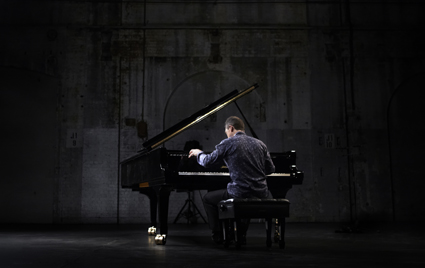
Michael Kieran Harvey, 2013, Carriageworks
photo Zan Wimberley
Michael Kieran Harvey, 2013, Carriageworks
At the end of Michael Kieran Harvey’s concert of three demanding Australian works for piano, played without an interval, I wandered onto the stage with curious others from the enthusiastic audience to inspect the magnificent Shigeru Hawai grand piano with which the pianist collaborated to produce sound on an orchestral scale. Harvey, his shirt sweat-drenched, had left the stage, looking pleased if somewhat frayed, providing only one curtain call while the audience clapped for more. I inspected the keyboard—no blood.
As a child I saw Cornell Wilde as the consumptive Chopin in the hugely popular, clunky biopic A Song to Remember (1946) coughing up blood mid-performance, Tyrone Power as popular American pianist and band leader Eddy Duchin (in the tear-jerker The Eddy Duchin story, 1956), his hand freezing over the keyboard (Duchin died of leukemia), and Dirk Bogarde who, oddly cast as Franz Liszt in Song Without End (1970), apparently practised the piano parts for filming until his fingers bled (Jorge Bolet provided the pre-recorded notes).
The heroic pianist, as Harvey reminded us in his witty introduction, was largely an invention of the piano virtuoso Liszt, whose aura quickly enveloped this concert in densely scored works that engaged both thunderingly and subtly with the entire keyboard. Recalling the death of Tatiana Nikolayeva as she played the Shostakovich Preludes and Fugues in a concert in 1993 Harvey regarded the huge Kawai with amused reserve.
An exacting performance for Harvey proved to be deeply pleasing for the audience, warranting considerable concentration. A champion of the Australian pianist and composer Raymond Hanson’s rarely performed Piano Sonata (1938-63; 20 minutes), Harvey told us that the work had been received as too radical at its first hearing and as too conservative in the 1960s. The sonata’s powerful, driving opening and the subsequent alternations between emphatic bass lines sparkling high note reprieves, a rippling middle ground, near-jazz inflections and overall building intensity felt nothing less than Lisztian, and certainly more romantically emotional than might be expected of a composer under the influence, said Harvey, of Hindemith.
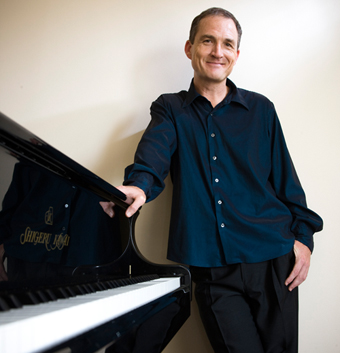
Michael Kieren Harvey
courtesy and © the artist
Michael Kieren Harvey
As promised, the second movement was lovely, its “air of mystery” rising from the left hand “like a fog horn,” and ending with a soft, rumbling, troubled gait. As with the opening movement, we were immediately plunged into intensely emotional drama on its way to gigantic waves of cascading notes (“The last two pages,” admitted Harvey, “are almost unplayable”). In between there were passages of great beauty, warm, lush, sweetly rippling and deeply chiming. Sonata and performance were wonderfully memorable.
Although the sonata is not programmatic, Harvey thought that it might have been prompted by the fall of France in World War II. It certainly is passionately defiant, withdrawing into reflection only to return more aggressive than ever. To complete the saga of death and the pianist with which I began, Hanson received the published score of his underrated sonata on the day he died in 1963. The good news was an instance of synchronicity—Hanson had played at the Eveleigh railway works, the site of Carriageworks, for the Railway Union Workers “on their 20-minute lunch breaks where he would also discuss his ideas for an Australian Trades Union Orchestra” (program note).
Psychosonata, Piano Sonata 2 (2012, 25 minutes), is one of Michael Kieran Harvey’s own compositions, a work, he said, that came out of “a low ebb.” He had intended to dedicate it to a helpful psychologist, but having done so with his first Sonata, he gave this one to his cat, Psycho.
Structuring the sonata around rising and descending nine-note lines, Harvey, like Lizst, if quite humbly, sees himself as attempting to create “a sound world different from anything before.” Like the Hanson, Psychosonata commences with a grand attack. Thundering bass lines and then upper note shocks and relentless riffing soon depart from high modernist hard-edged juxtapositions with sublime fluency, waves of notes rising and sinking into the deep against an insistent return to the unnerving counterpoint between the highest notes and the lowest. After the briefest of pauses, high notes, sweet but assertive are soon subsumed in a dense, cathartic fury, stutteringly staccato—a provisional finale to the fearful and liberating waves of ascent and descent that constitute Psychosonata.
Before commencing Elliot Gyger’s Inferno (After Dante, 2013), a 20-minute selection of eight movements from an hour-long cycle written for Harvey, the pianist sits perfectly still, hands on lap, seemingly staring deep into the score. This time the attack is vocal: a growl alternating with a squeal and other sounds, almost words, soon textured with piano notes in The Prelude: The Gates of Hell Canto III. The strikingly ‘unpretty’ vocal is reminiscent of the ‘non-operatic’ sounds of Ligeti’s Le Grand Macabre. “The nine lines of the inscription above the Gate of Hell…are transcribed, syllable by syllable, into rough-hewn piano gestures.” It’s an unsettling opening, performed by Harvey with conviction. In Acheron, low notes and high pulse and tinkle asynchronously to represent the disturbing movement of the river of Hades. We encounter the unbaptised (on an even more disorienting plane), the lustful (passionate, obsessed, opening up the range of the keyboard), the gluttonous (rhythmically furious, tormenting), the traitors (“frozen in everlasting ice” in the lowest depths of the piano) and Cocytus, the river of ice, moving in huge, heavily chorded shards. Relief comes with Postlude: The Stars, “as Dante and his guide emerge to see the night sky above them.” As in the Prelude, Harvey voices syllables from The Inferno, here with almost sub-vocal softness, in and out of synch with the piano, generating an eery, melodic and deeply satisfying beauty that evaporates into silence. It’s as if we’ve been unburdened of the emotional weight of the concert’s three works that had taken hold of our psyches.
Gyger writes that “each etude explores a different subset of the piano’s range,” which accounts for the work’s richness and the opportunities on offer for a brilliant pianist with a Lizstian vision and capacity. I long to experience the complete work. Congratulations to Carriageworks and its new music curator Louis Garrick for an adventurous program, so determinedly rewarding, promoting and celebrating bold Australian composition.
Carriageworks, piano, Michael Kieran Harvey, works by Raymond Hanson, MK Harvey, Elliott Gyger, new music curator Louis Garrick, Carriageworks, Sydney, July 19
RealTime issue #115 June-July 2013 pg. web
© Keith Gallasch; for permission to reproduce apply to realtime@realtimearts.net
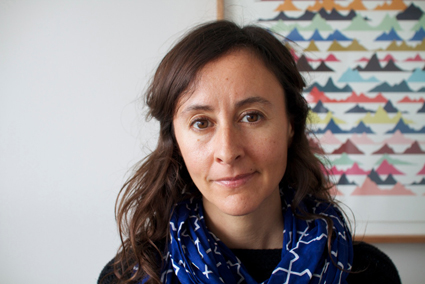
Nat Cursio
photo Pete Brundle
Nat Cursio
Natalie Cursio has assumed many roles over the years: dancer, choreographer, international collaborator, teacher, mentor, creator and curator. As well as making her own work, she has inaugurated a number of projects around dance in innovative settings.
For example, in 2010, she created Private Dances (Next Wave Festival), where one person would watch another perform inside a series of tents (see RT98), for which she won a Green Room award (Best concept and Realisation). She is currently Choreographer in Residence at the Newport Substation, where she is about to show a new work, Blizzard.
There’s nothing obvious about Cursio’s new work Blizzard that shouts Green. And yet Cursio speaks of Blizzard in relation to the planet, as a plea for care towards our dwindling bio-diversity. Her perspective is intriguing, relating to what she calls the “rawness” of the work, that is, its lack of artifice and theatricality. Through keeping the work raw, Cursio means to distil our attention towards the dancing and its sensory milieu: no music nor fancy lighting, just three bodies at work.
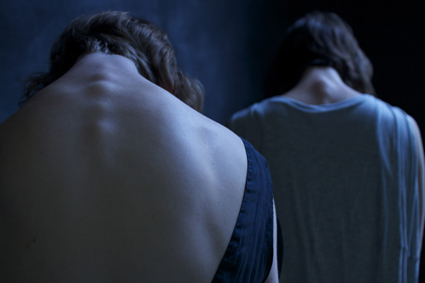
Blizzard, Nat Cursio Co
photo Nat Cursio
Blizzard, Nat Cursio Co
It’s not a big thing, dance. I am regularly struck by the fact that, digital work aside, dance is ultimately and always about the body. The greatest star might take the stage, but their medium is still their own body. Perhaps it’s this smallness which reminds us of the need for care. The audience must come to the work, paying attention to its quiet intensity. Cursio wants her audience to work on their experience rather than have it served to them on a plate. As a reminder that perception is a two-way deal, Blizzard, begins with an extended section that calls for eyes closed on the part of its audience.
We are in the old Newport power (sub)station, in a massive room flanked by epic windows, red bricks and a wooden floor. The train station is nearby. Cars pass, sounds of the city swell. Shuffling noises approach then fade. I cannot see what the dancers (Alice Dixon, Melissa Jones, Caroline Meaden) are doing but I can hear them. Their bodies are mechanisms for producing sound. My body is alert. Their movement provokes a kind of Doppler effect, consistent rhythms which perceptually vary according to their proximity to the observer. I feel them approach and retreat. Sitting in self-imposed darkness draws attention to my own body as mediator or rather receptor of the work. If vision launches itself into the world, hearing recoils towards home base. The dance is a cipher, muffled in the darkness.
When I open my eyes, there is a sense of familiarity as well as novelty, like meeting a relative for the first time. This is an unadorned piece. Cursio calls it raw but it is equally cooked. Blizzard was initiated in 2011 as an invitation from the three dancers who wanted some mentorship and direction from Cursio. Blizzard developed out of a series of improvisations by the dancers. Over time, Cursio became choreographer, working with a 20-minute section of improvised material as a basis for the work.
There is a feeling that the dancers retain a close relationship to their material. It belongs to them. That said Cursio sees her role as taking responsibility for the piece as a whole—to assume a global perspective—while the dancers retain responsibility for their own performative relation to the choreography. Hence a gentle enquiry from Cursio regarding their experience eking out the work after such a long break. The conversation is quietly geared towards some reflection on the part of the performer; how can I be present to this choreography, alert to its elements, stay involved in its minutiae? The dancers articulate their experience of the run-through. The task ahead is to find a way back into the choreography that sustains its complexity. That way may differ for each dancer. They recognise their mutual differences in approach. There is no effort to iron out these differences. Rather what is important is for each in their own way to find the depths of the movement, to stay in touch with the sensory present and to flesh out their own attention.
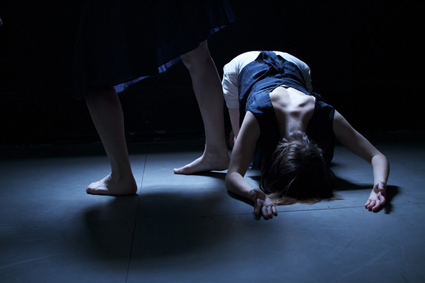
Blizzard, Nat Cursio Co
photo Nat Cursio
Blizzard, Nat Cursio Co
I won’t tell you what it looks like. I only viewed the beginnings of the last rehearsal period. One hint (hopefully not a spoiler) is that the audience will be seated in a circle. I mention this because of the ethical dimension of Cursio’s working with her dancers, that there is a kind of flow between them which manifests a certain kind of care. It would not be possible to make a work to inspire care on the part of humanity without practising that as a means of production. The circle signifies a kind of holding pattern, to be traversed by the dancers.
Things to come? Cursio has been commissioned as one of the artists for Carriageworks 24 Frames Per Second. She will also be performing solo (for the first time in a decade) in her own apartment in The Middle Room as part of Theatreworks’ ENCOUNTER(S) season in December. In development are Recovery, a work about grief and endurance performed with Shannon Bott and directed by Simon Ellis and the hilariously titled John Utans Was My Teacher (he was, so wait for that one), created by Cursio with Utans, Don Asker, Fiona Bryant and Tamara Saulwick.
Nat Cursio Co, Blizzard, The Substation, Newport, Melbourne, 30 July-4 Aug; http://www.natcursio.com
RealTime issue #115 June-July 2013 pg. web
© Philipa Rothfield; for permission to reproduce apply to realtime@realtimearts.net
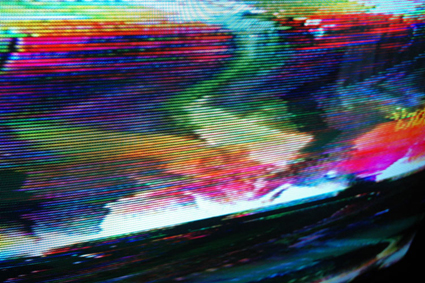
Tele Visions
Tele Visions, call for screen works
Another new screen-based festival has just been announced. Directed by Alex White and Emma Ramsay, Tele Visions celebrates the last days of analogue TV broadcasting and is calling for works for possible broadcast and exhibition that engage with “TV as a medium, the end of TV, TV’s history, TV’s content forms, the production and language tropes of performance for TV” (press release). Tele Visions will form part of the Performance Space 30 year celebrations later in the year.
Applications close 29 August; http://televisionsproject.org/
City of Sydney, accommodation grants
Subsidised spaces will be available from the beginning of 2014 in five City of Sydney properties in Erskineville, Glebe, Ultimo and Redfern. Applications are open to non-profit community and cultural groups for access to office space, meeting rooms, studios and workshops.
Applications close 23 July; http://www.cityofsydney.nsw.gov.au/community/grants-and-sponsorships/the-citys-programs/accommodation-grants
Still in the loop
Waverley Artist In Residence Program 2014
Deadline Monday 22 July 2013; http://www.waverley.nsw.gov.au/things_to_do/arts_and_culture/AIR_program/about_the_program
France 24 – Rfi Web Documentary Visa D’or Award 2013
Entry deadline 26 July, 2013
http://www.france24.com/en/webdocumentary-award-2013
2013 INSITE Award
Deadline 26 July
www.awg.com.au
Abbotsford Convent, Spiritous 2014
Applications due 29 July 2013
http://www.abbotsfordconvent.com.au/venues-hire/cultural-programming
Bundanon Artist Residencies
Applications close 2 August;
www.bundanon.com.au/content/residencies
PauseFest
Registration and final design submission August 15; http://pausefest.com.au/download_docs/pausefest2014_eoi_details.pdf
Australia Council upcoming deadlines
(for full list see http://www.australiacouncil.gov.au/grants)
Hopscotch, 19 July 2013
(for Market Development; National Touring, International touring)
http://www.australiacouncil.gov.au/grants/2013/hopscotch
Music: International Pathways – Round 4, 22 July 2013
http://www.australiacouncil.gov.au/grants/2013/music-international-pathways-22-july
Music: Peggy Glanville-Hicks Residency, 22 July 2013
http://www.australiacouncil.gov.au/grants/2013/peggy-glanville-hicks-residency
Emerging and Experimental Arts: Creative Australia – New (Art Creative Development), 01 August 2013
http://www.australiacouncil.gov.au/grants/2013/inter-arts-creative-australia-new-art-creative-development
Theatre: Cultural Leadership Skills Development, 5 August 2013
http://www.australiacouncil.gov.au/grants/2013/cultural-leadership-skills-development-theatre
Theatre: New Work, 5 August 2013
http://www.australiacouncil.gov.au/grants/2013/theatre-new-work
Theatre: Fellowships, 5 August 2013
http://www.australiacouncil.gov.au/grants/2013/theatre-fellowships
Creative Australia – Emerging Presenter, 12 August 2013
http://www.australiacouncil.gov.au/grants/2013/Creative-Australia-Emerging-Presenter
Creative Australia – New Digital Theatre, 12 August 2013
http://www.australiacouncil.gov.au/grants/2013/Creative-Australia-New-Digital-Theatre
International Markets – Music managers (Previously Live On Stage – Music Managers). 14 August 2013
http://www.australiacouncil.gov.au/grants/2013/international-markets2-music-managers-14-aug-2014
Dance: Artform Development, 16 August 2013
http://www.australiacouncil.gov.au/grants/2013/dance-artform-development
Dance: Fellowships, 16 August 2013
http://www.australiacouncil.gov.au/grants/2013/dance-fellowships
Dance: Projects – Creative Development, 16 August 2013
http://www.australiacouncil.gov.au/grants/2013/dance-projects-creative-development-16-august
Dance: Projects – Presentation, 16 August 2013 http://www.australiacouncil.gov.au/grants/2013/dance-projects-presentation-16-august
Dance: Creative Australia – New Work, 16 August 2013
http://www.australiacouncil.gov.au/grants/2013/dance-creative-australia-new-work
Visual Arts: Skills and Arts Development – Residencies, 19 August 2013
http://www.australiacouncil.gov.au/grants/2013/visual-arts-skills-and-arts-development-residencies
Visual Arts: Presentation and Promotion, 21 August 2013,
http://www.australiacouncil.gov.au/grants/2013/visual-arts-presentation-and-promotion
Visual Arts: Skills and Arts Development – General, 21 August 2013
http://www.australiacouncil.gov.au/grants/2013/visual-arts-skills-and-arts-development-general
RealTime issue #115 June-July 2013 pg. web
© RealTime ; for permission to reproduce apply to realtime@realtimearts.net
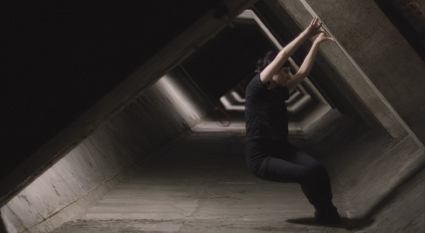
Gabriella Mangano and Silvana Mangano, Hidden Spaces, Ready Stages
courtesy of the artist
Gabriella Mangano and Silvana Mangano, Hidden Spaces, Ready Stages
Winter Season, Arts Centre
In addition to a very impressive season of major works in the main theatres— Philip Glass and Robert Wilson’s Einstein on the Beach (31 July-4 Aug), ADT’s Proximity (15-18 Aug) and US Dance company MOMIX’s Botanica (7-11 Aug)—Melbourne’s Arts Centre is also filling its hallways, foyers and rehearsal rooms with new commissions and site-responsive works. Visual artists Gabriella and Silvana Mangano have been prowling the underground tunnels and forgotten chambers of the complex to create a video installation titled Hidden Spaces, Ready Stages (27 July-4 Aug). Poet-in-residence Kate Larsen will be live tweeting poems displayed on the venue’s signage in Poetry by LED (5-11 Aug). An interactive audio tour, 5 x 5 x 5, sees emerging composers, mentored by leading artists, create works for five different locations around the centre experienced via personal MP3 players (27 July-18 Aug). Showing in the rehearsal rooms will be Saskia Moore’s Dead Symphony, a music and light show inspired by near-death accounts (7-10 Aug) and Swiss company Trickster-p will present .h.g., a haunted house version of Hansel and Gretel through which the audience amble with torch and iPhone app (8-11 Aug).
Winter, Arts Centre Melbourne; from July 27-18 August; artscentremelbourne.com.au
Old Kings in Exile, Soundstream Collective
Guest curator Brett Dean will be conducting the Adelaide-based Soundstream Collective in this program featuring leading Australian composers. Along with Dean’s Sextet (Old Kings in Exile) will be Richard Meale’s Incredible Floridas (the inspiration for Dean’s work), along with pieces by Anthony Pateras and James Ledger. The concert is co-presented by the New Music Network in both Adelaide and Melbourne. Look out for a review on the Matthew Lorenzon-RealTime new music blog, Partial Durations http://partialdurations.wordpress.com/.
Old Kings in Exile, Soundstream Collective; Adelaide, Elder Hall, 19 July, 7:30pm; Melbourne Recital Centre, 23 July, 7pm; www.soundstream.org.au/
The Capital Gains Consultation Project, Teik-Kim Pok
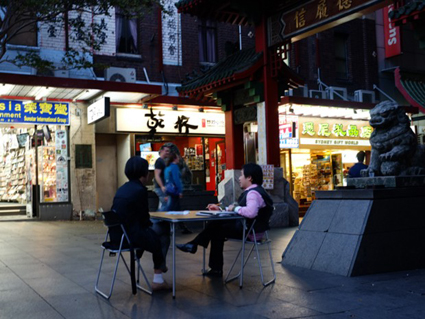
Teik-Kim Pok, The Capital Gains Consultation Project (2013)
courtesy of the artist
Teik-Kim Pok, The Capital Gains Consultation Project (2013)
Performer Teik-Kim Pok has been chatting to passersby and business owners in the Haymarket/Chinatown area of Sydney for the last year in an attempt to formulate a new transactional economy based on micro-narratives. You can join him for a meaningful exchange of wares on Friday night at the Dixon Street Markets. You can also submit stories and images to the blog.
4A Centre for Contemporary Asian Art, The Capital Gains Consultation Project, Teik-Kim Pok, Dixon Street Night Markets, Sydney, 19 July 2013, 5-9pm; www.4a.com.au/
White Rabbit, Red Rabbit, Malthouse
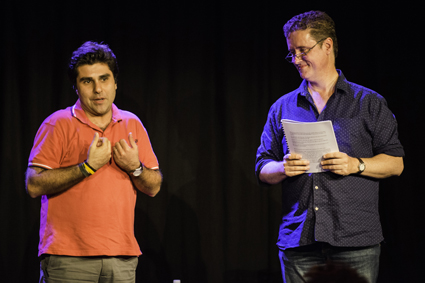
White Rabbit Red Rabbit, writer Nassim Soleimanpour stops the performance by Richard Fidler and introduces himself to the audience at WTF2013, Brisbane
photo Studio Impressions
White Rabbit Red Rabbit, writer Nassim Soleimanpour stops the performance by Richard Fidler and introduces himself to the audience at WTF2013, Brisbane
Witnessing Nassim Soleimanpour’s White Rabbit, Red Rabbit at the World Theatre Festival in Brisbane this year Stephen Carleton wrote: “It is an extraordinary theatrical experiment… It will influence writers, theatre stylists and experimenters of form and structure for years to come” (RT114). Melbourne audiences can now witness this unique theatrical creation in which, each night, a different actor is handed the script (previously unsighted) and must perform it, ably assisted by his or her audience.
White Rabbit, Red Rabbit, project curator Janice Muller, performers Rodney Afif, Alison Bell, Alan Brough, Shareena Clanton, Daniela Farinacci, Ming-Zhu Hii, Bert LaBonté, John Leary, Caroline Lee, Brian Lipson, Genevieve Morris, Brian Nankervis, Sam Pang; Malthouse, 23 July-3 August; www.malthousetheatre.com.au
Hello, Becky Hilton & Producciones La lagrima
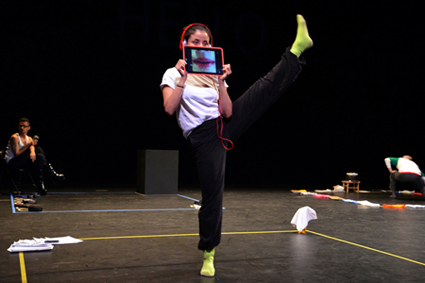
Alejandra Lopez Guerrero, Hello
courtesy Producciones La lagrima
Alejandra Lopez Guerrero, Hello
Hello is a cross-cultural long distance collaboration between Melbourne choreographer Becky Hilton and four young dancers from regional Mexican dance company Producciones La lagrima. Hilton has worked with the dancers via all communication conduits—Skype, Facebook, YouTube, text and chat—as well as face-to-face to create intimate dance portraits of these young people’s lives. The audience experiences the work first as an installation followed by a seated “traditional spectacle.”
Hello, Becky Hilton & Producciones La lagrima, 1000 £ Bend, 361 Little Lonsdale Street, Melbourne, 23-25 July;
www.helloprojectmelbourne.com/
Here&Now13, Lawrence Wilson Gallery
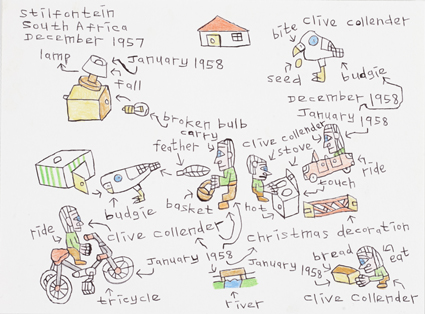
Clive Collender, Stilfontein, South Africa, December 1957, 2013, pencil and pen on paper
image courtesy and © the artist, photo Acorn Photo Agency
Clive Collender, Stilfontein, South Africa, December 1957, 2013, pencil and pen on paper
Here&Now13 is a survey exhibition showcasing the work of 11 Western Australian artists. The artists have been in a year-long development and mentorship program produced by DADAA (Disability in the Arts, Disadvantage in the Arts WA). Curator Katherine Wilkinson sees the exhibition as part of a “growing national and international trend to contextualise disability arts practice within the larger narratives and discussions of contemporary art…not attempting to define its lineage or rely on the model of Outsider Art” (press release). The exhibition will be accompanied by a symposium featuring keynote speaker Carrie McGee, Educator in Community and Access Programs, Department of Education at MOMA, New York.
Here&Now13, artists Katrina Barber, Patrick Carter, Clive Collender, Aquinas Crowe, David Guhl, Tim Maley, Julian Poon, Jane Ryan, Robert Turpin, Lisa Uhl and Robin Warren, Lawrence Wilson Gallery, University of Western Australia, Perth; 27 July-28 September; www.lwgallery.uwa.edu.au; http://www.dadaa.org.au/
Home 3, Olaf Breuning, IMA
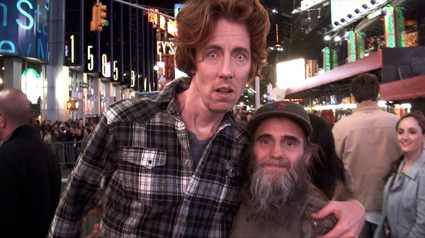
Home 3, Olaf Breunings
courtesy the artist
Home 3, Olaf Breunings
Wandering through a gallery in Denmark a few years ago I came across Swiss artist Olaf Breuning’s Home 2. It’s a disturbing half-hour video in which a bumbling American, Brian Kerstetter, with alarmingly red hair and reptilian contact lenses, tramps through Japan, Papua New Guinea, Switzerland and Ghana. He talks incessantly, portraying the Western world at its most idealistic, naïve, misguided and often offensive. Kerstetter (who possibly may be Breuning—one of art’s little secrets) has all the cringe-worthy yet compelling and revelatory qualities of Ali G. The final work in the Home trilogy sees Kerstetter take on New York, and is currently screening at IMA.
Home 3, Olaf Breuning, Institute of Modern Art, Brisbane; 8 June-27 July; http://www.ima.org.au/pages/exhibitions.php
Still in the loop
Queensland Music Festival
Various venues, QLD, 12-28 July
www.qmf.org.au
TeleScope: Visions from the EU, online screenings
Melbourne International Film Festival
25 July-11 August
http://miff.com.au/program-categories/telescope
Intra-action: Multispecies becomings in the Anthropocene
MOP Gallery, 11-28 July
http://intraactionart.com/
Maude Davey, My life in the Nude
La Mama Theatre, 21 July;
http://lamama.com.au/
Fraught Outfit, Persona
Belvoir, 24 July-18 Aug
http://belvoir.com.au
Personal Space, Tanya Lee
Fremantle Arts Centre
until July 21
http://fac.org.au
Live and Deadly, Carriageworks
27 Jun-1 Aug
http://www.carriageworks.com.au/?page=Event&event=LIVE-AND-DEADLY
My Country, I Still Call Australia Home: Contemporary Art from Black Australia
Queensland Art Gallery/Gallery of Modern Art, 1 June-7 October
http://www.qagoma.qld.gov.au/exhibitions/current/my_country
Helium Season, Malthouse
8 June-5 Oct, see website for following productions
www.malthousetheatre.com.au/helium-2013/
Finucane & Smith’s The Glory Box…Paradise
45 Downstairs, Melbourne, 10 July -11 August
http://www.fortyfivedownstairs.com/events/
Anne Ferran, Box of Birds
Stills Gallery, Sydney; 26 June to 27 July 2013
www.stillsgallery.com.au
Vocal Folds, Gertrude Contemporary
21 June-20 July; performances 11 July, 18 July
www.gertrude.org.au/exhibitions
RealTime issue #115 June-July 2013 pg. web
© RealTime ; for permission to reproduce apply to realtime@realtimearts.net
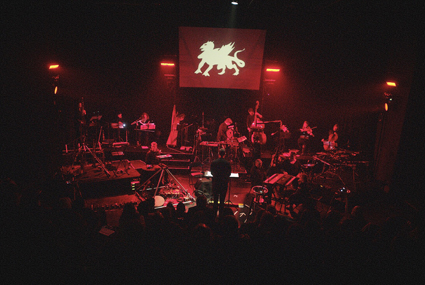
The NIS, The Amplified Elephants, BOLT Ensemble
photo Tim McNeilage
The NIS, The Amplified Elephants, BOLT Ensemble
A recording of the roar of a vast crowd fills the pitch-black auditorium of the Footscray Community Arts Centre for the opening of The NIS, an all-abilities sonic arts show featuring The Amplified Elephants and the BOLT Ensemble. They could have just left the lights on, because the house was packed with an excited audience who had braved the wind and rain to see the show.
A red searchlight reveals the winds, strings, harp and percussion of the BOLT Ensemble. Downstage, The Amplified Elephants are seated next to gleaming robotic structures: a frame of bells and an apparatus, the Gotholin, which draws violin bows across four violins. Teagan Connor punctuates the ambience with an eerie scraping from the instrument. A harp line (Mary Doumany) follows in its wake. Activated via a synthesiser keyboard, Robyn McGrath releases a jangling peal of bells from a robotic carillon. As Doumany begins playing sweeping glissandi, an incredible oscillating sound rises from the Whirling Dervishes—power drills with sound-producing bowls attached. Flashing coloured lights heighten the tension in the Lost World Auditorium, as the piece is entitled, signaling our entrance into the dream-like, symbolic world of The NIS.
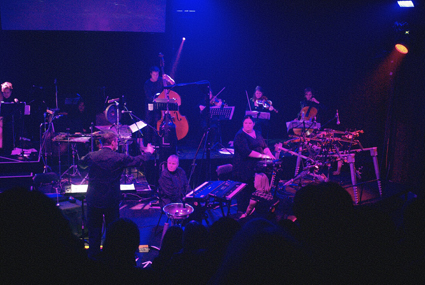
The NIS, The Amplified Elephants, BOLT Ensemble
photo Tim McNeilage
The NIS, The Amplified Elephants, BOLT Ensemble
“Worker,” “god” and “wolf” are some of the archetypes explored through the concert’s nine movements with the help of Tien Pham’s dark animations and a series of interviews and field recordings. Connections are developed between the symbols of the politician and the wolf, corporations and global warming, even god and the wolf, as well as a host of other characters, at times subjects, at others objects of discourse: workers, children and animals. The animations also double as games, generating parts of the music. In one animation, a crowd of figures wanders between traffic lights in a sun-baked wasteland, fragments of musical scores for different instruments appear onscreen prompting changes in the sonic landscape.
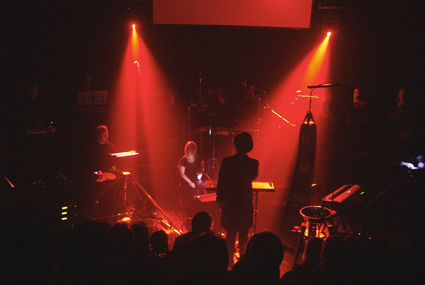
The NIS, The Amplified Elephants, BOLT Ensemble
photo Tim McNeilage
The NIS, The Amplified Elephants, BOLT Ensemble
First performed in 2009 at Fortyfivedownstairs, this show has developed over the years. At the Footscray Community Arts Centre the theatrical interventions of The Amplified Elephants were missed, though Kathryn Sutherland’s playing of a punching bag fitted with pressure-sensitive triggers echoes the show’s original physicality. The ensemble has also grown to include Thomas Lutze (Pedal Triggers), Teagan Connor (Whirling Dervish and Gotholin) and Daniel Munnery (Tiny Tappers and sampler). The dynamic lighting and impressive technological resources of The NIS add drama to the relatively static composition, where fleeting gestures and sudden whispers disappear into the soundscape as soon as they appear.
As Director James Hullick writes in his program note, linear narrative is not the only way in which to understand ourselves and works of art. Sometimes a freer juxtaposition of ideas and sounds is needed, even when they may only appear once, undeveloped and do not have any real-world correlates. This approach is summed up in the show’s title, The “NIS,” which, like the famous hapax “ptyx” of the French poet Stéphane Mallarmé, is a word invented by Katherine Sutherland to signify nothing. This play of signifiers is not entirely empty, however, as through this juxtaposition of ideas The NIS also brings together communities, as the large list of collaborators shows, to produce a thought-provoking and multi-faceted performance.
The Click Clack Project: The NIS, The Amplified Elephants, BOLT Ensemble, Footscray Community Arts Centre, 4 July; http://www.clickclackproject.org/
RealTime issue #115 June-July 2013 pg. web
© Matthew Lorenzon; for permission to reproduce apply to realtime@realtimearts.net
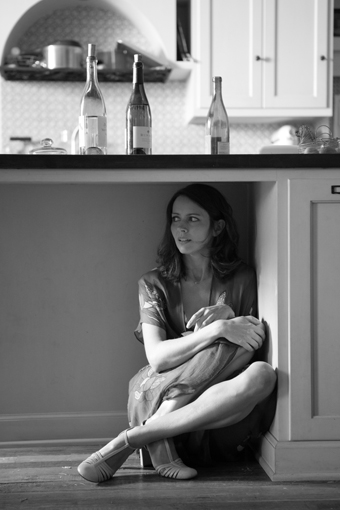
Much Ado About Nothing, Joss Whedon
courtesy Sharmill Films
Much Ado About Nothing, Joss Whedon
Look, I’ll admit it. I loved literature but I initially found Shakespeare hard work. We studied one play every year at high school. Romeo and Juliet. Macbeth. The Merchant of Venice. They are the ones that spring to mind.
I remember the terrible Dire Straits song that we had to listen to (our teacher being very ‘modern’) and a lot of wringing hands—blood that could never wash off. I remember little deaths and the screams of laughter when our teacher, blushing, revealed what those words meant. I remember terrible films, full of arch overacting and stiff costumes, that were an endurance test. Or, even worse, the outings to plays where the whole audience of schoolies could not stop giggling at the sight of men in tights, the laughter so loud it drowned out the actors’ lines.
I found Shakespearean language and most poetry (until I came to Emily Dickinson) like a locked box. I couldn’t find a key until Year 11 when I had a teacher who was a passionate guide. As he started to work carefully through the language with precision, I began to realise that Shakespeare was funny. And possibly relevant. I started to enjoy the shape of it on my tongue. Sex and death? As a teen I was obsessed with both. Wasn’t everyone?
Baz Luhrmann’s Romeo + Juliet put an end to my lingering distrust. It was fresh, exciting, operatic in scope, full of sound and fury (of course it signified something) and the romance was palpable. I remember sitting in the Orpheum, thinking about whether to buy another ticket and start over again. Most of all, I finally understood the writing, the language, without having to struggle.
Look, I’ll admit it. I’m a fan of Joss Whedon. I’m one of those people who came late to his shows, but I watched Buffy episodes all in a row on Friday nights with my best friend and then Angel in parallel so I could enjoy the interconnecting narrative. Then I watched everything else he ever made. I saw him speak at Melbourne Town Hall when he toured here. A friend commented that he could make toast and it would be interesting to watch.
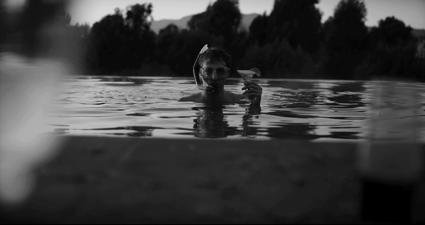
Much Ado About Nothing, Joss Whedon
courtesy Sharmill Films
Much Ado About Nothing, Joss Whedon
When I heard he was taking on Shakespeare, I wasn’t really surprised. He chose Much Ado About Nothing because of its location (it could be made all in one spot) and then filmed it in the house where he lives in Santa Monica with his family, over 12 days. I saw the film in an audience of fans. And this time the crowd was laughing for the right reasons. Like Luhrmann, Whedon has a talent for translation. The film is shot in black and white, yet contemporary, with parties that never end and paparazzi who capture the dregs. It traces the oblique nature of relationships and the shifting spaces between what men/women say and what they really mean.
The actors deliver their lines with Whedonesque drollness and the physical staging is innovative in confined spaces. Amy Acker as Beatrice and Alexis Denisoff as Benedick battle it out wordily in screwball comedy style, while Whedon brings in all his other regulars, often against type. It feels like a family affair and in fact it was. His co-producer on the film (and wife) Kai Cole did a Skype interview at the film session I attended. She said that for many years they had regular Shakespeare readings in their home and the film emerged with the same actors involved. Much Ado has the manic energy that low-budget collaboration with great actors seems to create, even though it’s not improvised. (This “real” feel reminds me of Cassavetes.)
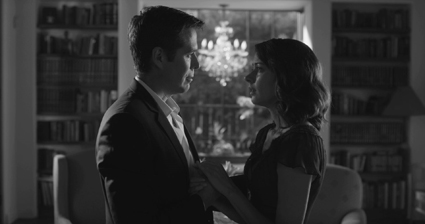
Much Ado About Nothing, Joss Whedon
courtesy Sharmill Films
Much Ado About Nothing, Joss Whedon
As a writer and director, Whedon has always been interested in girls and women—their place in society, how they subvert the stereotypes—and here he cleverly questions Shakespeare’s assertions about women’s rights and virtues from within, while sticking tenaciously to the script. Lines I remember as tedious he manages to subvert with a quick nod of the head, or a smirk, so they can also mean the opposite. And as always he remains focused on nerds—the smart, cute, funny types who win using brain rather than brawn. For teenagers (or adults like me) coming to Shakespeare today, this film is a great way in to the heart and energy of the language; Whedon is a passionate, acerbic and sexy guide.
Much Ado About Nothing, director Joss Whedon, Australian distributor Sharmill Films, in cinemas from 11 July; http://www.sharmillfilms.com.au
RealTime issue #115 June-July 2013 pg. web
© Kirsten Krauth; for permission to reproduce apply to realtime@realtimearts.net
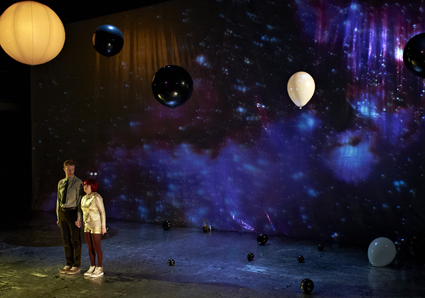
Robert Jago, Natalie Holmwood, ALIENATION, Perth Theatre Company
photo Richard Jefferson
Robert Jago, Natalie Holmwood, ALIENATION, Perth Theatre Company
Three individuals contacted by an otherworldly power are thrown into an existential quandary; beliefs are interrogated, relationships torn and internal isolation grows. Drawing on interviews with alien abductees in Australia, Perth Theatre Company’s ALIENATION seeks to tell the stories of those who have been touched forever by ‘close encounters’ that are rationally inexplicable yet life-changing, psychologically and philosophically.
The aesthetic vision of director Melissa Cantwell and her designers is simultaneously stark and textured. However there is a tonal ambiguity and lack of narrative impetus that weakens the piece overall. Based on interviews ALIENATION very quickly shapes into a type of verbatim theatre with a proclivity towards static story-‘telling’ rather than showing—confessional outpouring with little action or interactive dynamic to drive the scenes forward.
This approach is coupled with a meta-narrative structure in which the actors reveal they will be playing themselves as well as the interviewees. Perhaps an attempt to acknowledge that the characters are based on real people, instead the device undermines the interviewees’ experiences. By having the ‘actors’ (also characters) reveal varying degrees of belief ranging from ambivalent to facetious to explicitly sceptical, a tone of doubt is created. This forms the subtext in which there is little conviction given to the source material—at times seeping into the actors’ portrayal of the interviewees, manifesting as an undertone of ironic distance. This would be fine if ALIENATION intends to plant seeds of doubt in our acceptance of the characters, but this never seems explicit, rather it is an underdeveloped device exploring the thoughts of both sceptic and believer with limited success.
This is possibly a reason why the writer—who has expressed his compassion for the interviewees’ and their experiences—has distanced himself from the piece. A note written by the playwright Lachlan Philpott (Truck Stop, Silent Disco) is handed out to each audience member stating the production does not reflect his intentions. Subsequently his name has been removed from the program and Perth Theatre Company’s website since the production opened and the Sydney season of the production cancelled. (A statement has since been issued by Philpott through the Australian Writers Guild. Eds.)
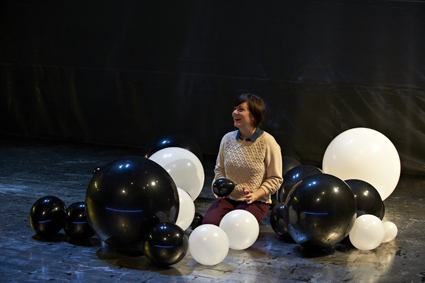
Natalie Holmwood, ALIENATION, Perth Theatre Company
photo Richard Jefferson
Natalie Holmwood, ALIENATION, Perth Theatre Company
You will want to see this work for Natalie Holmwood’s portrayal of Katherine, a woman who was first abducted at a very young age. Katherine is a rich and well-developed character and Holmwood embodies all of her pained, oddball yet awkwardly endearing traits. She extracts audience sympathy for Katherine as she tries to make sense of her experiences, to become something more than a victim, a curiosity and a pariah. With her flashbacks, night terrors, numbness and self-loathing she is clearly a survivor of unexplained horrors whatever their source may be.
The rest of the cast are committed to their roles but are working with thin material: their characters have not emerged as fully formed as Katherine. They are tenuous, opaque and sometimes clichéd, which makes the meta-narrative perspective even more—ahem—alienating.
The audiovisual and lighting designs—by Roly Skender and Benjamin Cisterne respectively—bring a dreamy tension to the piece and could perhaps have been further utilised to construct the sense of disorientation and discombobulation experienced by each character, rather than these being, in the main, reported in long expository monologues. Peter Dawson’s sound design is sparse and delicate, but bookended and punctuated by some overbearing popular music choices—including overt space-themed classics by Bowie and The Byrds and a swooning love ballad from Aerosmith—adding to the overall tonal discrepancy of the work.
There are pockets of whimsy and sardonic humour throughout; there is sadness and an unsettling tremor in each character. However the vacillation between parody and drama results in a less than captivating work.
Perth Theatre Company, ALIENATION, director Melissa Cantwell, performers Naomi Hanbury, Luke Hewitt, Natalie Holmwood, Robert Jago, designer Bruce McKinven, lighting Benjamin Cisterne, sound designer Peter Dawson, audiovisual designer Roly Skender, research consultant Mary Rodwell (Founder of the Australian Close Encounter Research Network); Studio Underground, State Theatre Centre of Western Australia, 28 June-13 July
RealTime issue #115 June-July 2013 pg. web
© Astrid Francis; for permission to reproduce apply to realtime@realtimearts.net
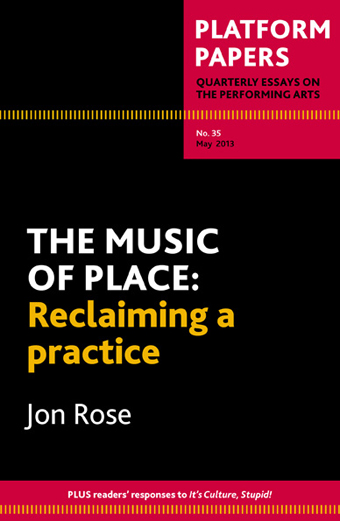 Opportunities for focused debate on the arts in Australia are somewhat rare. The Currency House Platform Papers series provides an important forum and addresses a range of issues around the changes or decline (whichever way you see it) in Australian arts practices and major performing arts institutions. A glance through the catalogue suggests a reasonable commitment to music from a range of voices, albeit one primarily focused on contemporary classical music and jazz.
Opportunities for focused debate on the arts in Australia are somewhat rare. The Currency House Platform Papers series provides an important forum and addresses a range of issues around the changes or decline (whichever way you see it) in Australian arts practices and major performing arts institutions. A glance through the catalogue suggests a reasonable commitment to music from a range of voices, albeit one primarily focused on contemporary classical music and jazz.
Perhaps reflecting a desire by the editors to expand the frame for Australian music, the series recently departed from more mainstream voices to include a paper on live music from popular music writer Clinton Walker, History is Made at Night. Such diversification has been bolstered by the latest paper, The Music of Place: Reclaiming a Practice, by musician Jon Rose, perhaps Australia’s best known and most senior improvising musician, whose early career grew out of the Australian and European free improvisation scenes in the 1970s and 80s. Rose operated for many years in artist-led underground scenes and came to prominence via his prolific output and collaborations with key international players in improvised music and ‘progressive’ new music.
Rose’s offering is a bold manifesto for arresting the decline in the value of music in Australian society, underpinned by a sense of cultural amnesia around the complex interwoven musical histories across Indigenous and non-indigenous cultures. The paper is structured on a thematic level around a critique of the dominant understanding of Australian music history; the relationship of music to place, landscape and society; perceptions of the value of music; music in public life; and the condition of music in an increasingly technologised world.
To set the tone for the paper Rose writes, “not so long ago a musicologist at a Sydney University seminar observed, ‘Everybody knows that music in Australia didn’t really get going until the mid-1960s.’” This historical lie becomes a ‘hook’ that provides the paper with a sense of real purpose and throws into stark relief the prevailing myopic academic and institutional view of Australian music that becomes one of Rose’s key targets. It is not so much the injustice arising from a situation where “the loudest lie becomes the truth” (as John Zorn writes in the preface) so much as the way in which this kind of skewed outlook prevents us from understanding the true role (and value) that music has had, currently has and may potentially have within Australian culture.
Rose confronts this somewhat absurd portrayal of Australia as an outpost of Europe in which little of historical value might have occurred and suggests that such readings of Australian music have contributed to its devaluing, not just historically and culturally, but also economically. In response, he sets about the task of constructing an alternative narrative (which he calls “the other Australia”) that connects the history of Indigenous music making with Australia’s colonial history in useful and persuasive ways. Rose sketches the musical interactions between the Indigenous population and ‘whitefellas’ from the early 19th century, the influence of the church missions of Hermannsberg and New Norcia with their curious syncretic musical outcomes, and the idiosyncratic musical scenes that grew out of 19th century Australia. He concludes with an outline of Australia’s rich history of musical instrument design and early experiments in electronic music that challenge the dominant view that electronic music started in the 1950s.
In compiling this alternative narrative, Rose draws heavily on the work of musicologists John Whiteoak and Alison Rabinovici, supplemented by private conversations with a range of practitioners. Rose’s main contribution here is the idea that this false history around Australian music constitutes a major stumbling block for its future—that the fundamental lack of awareness of our own history found among musicians and major institutions presents us with a kind of dead end.
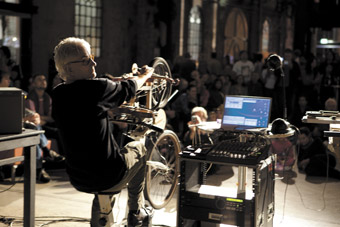
Jon Rose, Pursuit
photo Alex Davies
Jon Rose, Pursuit
Rose proposes, as an alternative, a rethinking of music that grows out of a return to first principles—where music reconnects with concepts of place, landscape, everyday life and the Australian vernacular. Invoking ironic references to European modernism, Rose offers examples of Australian sprechstimme—the race-caller or auctioneer and, with a nod to Olivier Messiaen, suggests that our native bird-song “should be standard knowledge and repertoire.” He further outlines the possibilities for outdoor performances and suggests that Australians’ love of sport could be seen as a fruitful site for musical engagement, citing his own work Perks (1995)—“an interactive badminton game based on the mind and obsessions of Percy Grainger”—and Pursuit (2009) “a bicycle powered orchestra event of hand-made musical instruments.” The thrust of these arguments rests on notions of “embeddedness,” where music is interwoven once again into the fabric of everyday life and connects in authentic ways with our environment and culture.
Rose offers a range of provocations around funding arrangements for major arts institutions and how they may act as barriers to achieving the aim of increasing the value of music and musicians. In a section entitled Resisting the capitalists, Rose cites Australia Council funding distributions where in 2009 “Opera Australia received more funding…than all the applicants for all six of the Australia Council’s major boards combined…That’s one opera company receiving more than seven hundred and eighty one separately funded projects across all those forms.” In the following section, New buildings or new resources?, Rose cites a $1.148 billion spend on major public buildings in the last decade, yet “none of this actually goes to employing musicians to play music…How many open-air concerts of new music could we get for $1.148 billion, hiring ten musicians a concert at $500 each? Some 2,296,000 concerts.” Much of Rose’s argument centres on the idea that we have a system of institutional support that is poorly calibrated towards achieving a vibrant and distinctive future for Australian music. He proposes that we consider what would happen if all this funding were removed and music needed to find a new context that arose out of authentic expression and basic value exchange.
In respect of new technologies Rose takes a fairly dim view of the promise of the internet, arguing that it has provided little concrete assistance to musicians (“the internet is a self-replicating, self-reflective system of almost pure noise”), and further, that the old way of organising tours via letters and telephones was more fruitful and efficient. He concludes his assessment of our digital present and future by re-asserting the value of physical presence and the body as key agents in musical exchange, “music without the agency of the body is music without breath.”
This is an expansive and engaging view of the state of Australian music. Rose’s approach to this Platform Paper closely resembles his prolific and influential musical output. His arguments demonstrate a lateral, creative form of thinking that challenges traditional understandings of history, culture and genre, resulting in a provocative collision of ideas out of which a powerful logic emerges.
Plaftform Papers: Jon Rose, The Music of Place: Reclaiming a Practice, Currency House http://www.currencyhouse.org.au/node/278
See Jon Rose’s response to City of Sydney public conversation on live music 26 June; and a review of Jon Rose’s 60th Anniversary CD box set, Rosin
This article fist appeared as part of RealTime’s online e-dition July 10, 2013
RealTime issue #116 Aug-Sept 2013 pg. 48
© Julian Knowles; for permission to reproduce apply to realtime@realtimearts.net
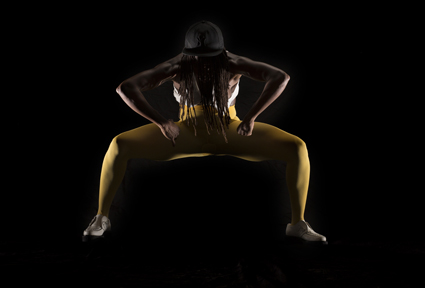
Dana Michel, Yellow Towel
photo Maxyme G Delisle
Dana Michel, Yellow Towel
Recent scholarship in performance and neuroscience reveals that spectatorship is a skill. Perception—visual, aural, olfactory and tactile—is something we learn and get good at. As spectators, we look for a challenge. Too much and we disconnect. Too little and we’re bored. Theatre scholar Bruce McConachie says spectators are always looking for a worthy play partner (Engaging Audiences, 2011). I have five days at Montréal’s FTA and I’m looking for artists with good game.
Dana Michel, Yellow Towel
A figure in black hoodie, baseball cap and pants has descended almost to the floor in an awkward splits. She has one foot in a white inflatable toilet that is beginning to collapse. The other foot is falling out of a black-and-white platform sneaker, revealing a yellow sock. Finger, arm, hip and leg move in contrary directions, each with a mind of its own. Taken as a whole, the gestures are a strange assemblage of North American Black culture clichés—everything from gangsta to Rasta to Fat Albert cartoons mashed together. Choreographer-performer Dana Michel (Band of Bless, Canada) stretches the stereotypes about as far as you can. She also transcends the clichés through uniqueness of movement and an uncompromising ability to be in the moment. Michel gives the impression of not knowing what she’s going to do from one nano-second to the next. Reporting on the weather, she gathers materials as if by accident, tearing a patch of paper from a roll and producing a marker. In a rambling manner she describes meteorological conditions that never quite add up to a forecast—all the while shifting randomly between various Black dialects. By the time she gets to the task of drawing on the paper it has been reduced to a scrunched-up ball. Dutifully and haphazardly she makes a mark on it. Yellow Towel is weird, insightful and hilarious without resorting to predictable contrivances. It achieves a state of imbalance that is revelatory.
Thomas Ostermeier, An Enemy of the People
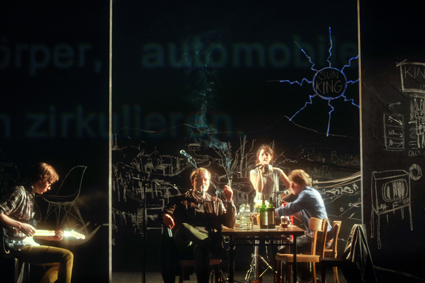
Un Ennemi du Peuple, Thomas Ostermeier
photo Arno Declair
Un Ennemi du Peuple, Thomas Ostermeier
In director Thomas Ostermeier’s (Germany) version of Ibsen’s classic play, hipster versions of Dr. Stockman and his family live in an artist warehouse where they eat, hang out with friends and rehearse covers of Gnarles Barkley and “Eye of the Tiger.” The overall impression is of a laid-back community that values creativity, free speech and the environment. But when Stockman attempts to alert the townsfolk that the local baths, a major source of revenue for the town, are polluted, he is blocked by interests at City Hall and the homeowners’ association. Science versus profit. Truth versus the evils of majority rule. What to do?
Ostermeier hands the question to the audience at Théâtre Jean-Duceppe. The furniture is pushed to the side. The actors literally try to whitewash the issue by throwing paint over the set, which now becomes the site of a town hall meeting. Actor Stefan Stern as Stockman steps up to a podium to address the house directly. Fellow cast members circulate among the audience encouraging responses.
By timely coincidence, the City of Montréal is experiencing its own water contamination issues, the result of corruption and poor management at the civic government level, so the spectators are vocal. But the issues appear to be unresolvable. This is, after all, a middle-class theatre-going crowd. Fixing such problems might require personal sacrifice in the form of higher property taxes and the like. Can a society built on the individual’s right to own property put collective good ahead of material loss? The debate is exciting, but the tendency of this theatrical form and its relatively wealthy audience is to keep the confrontation within manageable limits. We won’t be spilling into the streets to tear down the little castles—too many of us own one of them (I don’t, but I often wish I did). All things considered, the appropriate response is resignation.
Marie Brassard, Trieste
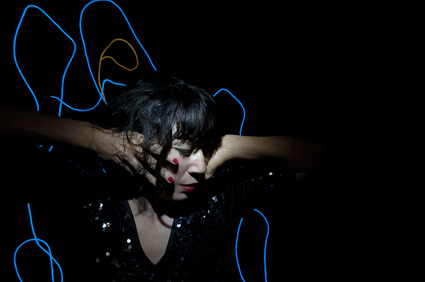
Marie Brassard, La Trieste
photo Minelly Kamemura
Marie Brassard, La Trieste
Marie Brassard (Canada) sits on a high stool front-and-centre. Clad in black from neck to foot, she recedes into the dimly lit surroundings. Her pale face seems at times to float, ghost-like, in space. She speaks of Trieste, a city haunted by literary figures of the past—Dante, Rilke, Joyce. As in her other work, Brassard creates a romantic dialogue with memory and literary history. Faded sepia images of Trieste flicker in the background, always just out of focus, as if viewed through the scratched lenses of a 19th century stereoscope. Two musicians at a table stage-left perform a sound score that is… well… typical of such sound scores—atmospheric, with even tempo and dynamically narrow. Brassard’s narration is likewise measured. Too measured—she seems hypnotised by her own voice; Trieste seems caught in its own spell. Apparently, literary ghosts are legato creatures—they don’t break rhythm. Trieste could use a staccato spectre to inject a jagged surprise or two.
Markus Ohrn, Conte d’amour
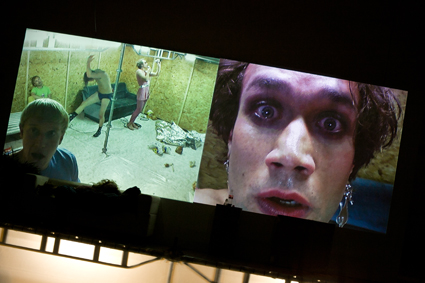
Conte d’Amour, Markus Ohrn
photo Robin Junicke
Conte d’Amour, Markus Ohrn
Spectatorship is never a passive act. We imitate what we see on a neuromuscular level. With our feeling bodies we also make predictions about what will happen next—where or how the actor will move, what she will say. Even in a seemingly static human-centred installation there is micro-movement. There is a particular quality to the unfolding of time. Unpredictability is what engages us. This seems to be lost on too many performance makers and curators. I can’t count the number of shows I’ve seen where one thing happens, I understand that thing early, and it does not change. I’m so far ahead that there is no game to play.
Markus Ohrn, director of Conte d’Amour, says he isn’t worried about boring the audience. He creates an interesting mise en scène: a two-storey structure with a living room on top and a basement underneath, the interior obscured by a thick plastic sheet. Through the sheet several figures are just barely visible, but we get plenty of close-ups of them through live video-feeds from inside the room. A father figure keeps three young men hostage there. For three hours of performance-time he plays a game of dominance and submission with them, feeding them, playing sex games etc. For about 10 minutes the feeling is of creeping horror. Then, as Ohrn intended, the banality of the situation takes over. Horror gives way to boredom and disinterest.
Ohrn, citing his favourite literary critic, argues that the act of paternalistic sex slavery, based as it is on real-life incidents of this nature, is a deviation that transforms love into its opposite. But the situations in Conte d’Amour’s and its real-life equivalents are so extreme they offer no insight into the nature of possessive love. Love has nothing to do with it. Ohrn, however, intends to drive his thesis home with facile, ‘ironic,’ biblical references to fatherhood and with too many live renderings of English-language pop songs that are oh so on-message—“Love will tear us apart again.”
From this I must conclude that Ohrn is a traditional moralist. To ensure we understand that perpetrators of such crimes are not Hollywood villains, but very banal creatures, he drip-feeds us three hours of tedium. Tough medicine, but it’ll strengthen our moral resolve. If, however, you happen to be looking for a greater aesthetic challenge, if you want to wrestle with real moral complexity, watch an episode of The Wire.
Xavier Le Roy, Le Sacre du Printemps
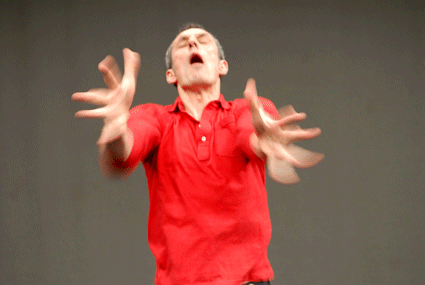
Xavier Le Roy, Le Sacre du Printemps
photos Vincent Cavaroc
Xavier Le Roy, Le Sacre du Printemps
Xavier Le Roy, one of the innovators of contemporary French non-danse, performs the part of conductor in a deconstruction of Stravinsky’s groundbreaking orchestral work The Rite of Spring. He stands alone and conducts in the direction of the audience. Audio speakers have been placed beneath our seats so that we may take on the part of specific instruments. Le Roy might gesture toward one of us as the piccolos sound, and the piccolos will announce themselves from where we sit. He does not use a baton. Rather his whole body is a hopping, thrusting, multi-limbed wand. My understanding of the word deconstruction is “to open something up to multiple meanings.” Le Roy, by embodying The Rite of Spring in this way, is opening it up to multiple hearings. I listen to the score in a new way. But, as Le Roy puts it, I also “listen to movement,” in a new way.
Festival TransAmériques (FTA), Montreal, Canada; 22 May-8 June; http://www.fta.qc.ca/en
This article first appeared as part of RealTime’s online e-dition July 10, 2013
RealTime issue #116 Aug-Sept 2013 pg. 24-25, web
© Alex Lazaridis Ferguson; for permission to reproduce apply to realtime@realtimearts.net
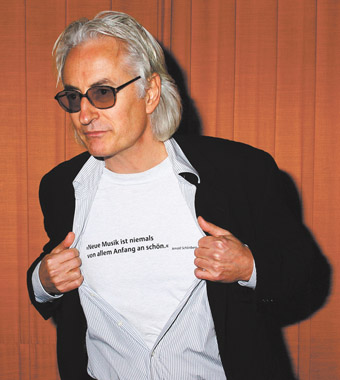
Jon Rose, “Neue Musik ist niemals von allem Angfang an Schön” (New music is never very nice at the beginning)
The title of the City Conversation on 26 June was “You Can’t Stop the Music…unless you have a properly approved Noise Abatement Order.”
You can't stop the music. But you can certainly hinder public debate on the matter.
I've earned my living as a musician for 40 years, mostly playing music that could be described as ‘unpopular,’ but somehow I've survived as the situation for both popular and unpopular music has recently reached impossibly low levels of general interest and sustainability. The public won't pay what it costs to support live, kicking musicians of any genre; they will pay for expensive meals, holidays and the latest shiny piece of technology, but they will not pay the true cost of live music.
Without government subsidy (ie arts funding or the dole—most performing musicians’ income) the entire edifice of music performance in Sydney (and most places in Europe) would crumble, leaving the practice of music as an amateur past time. I care about this; so much so, that I wrote a small book on the subject—suggesting options for changing the situation.
The City Conversation at The Sydney Town Hall on 26 June left me wondering if the whole event was trying to do something to transform the dire situation for live music in Sydney for the better, or the worse.
A colleague and I had with us a small flyer advertising the existence of two books published by nonprofit Sydney publisher Currency House: History is Made at Night: Live Music in Australia by Clinton Walker, and my own The Music of Place: Reclaiming A Practice—both relevant reads to the task in question. Could we leave these flyers on the seats? No, we could not, I was informed. Why not? I asked. Because this event does not allow advertising, was the reply.
I explained that it is on the very subject we are discussing, it is not for profit etc, but to no effect. I asked a gentleman sitting in the next row if he would like one. Yes, he said. So I handed one to him. The official in black swooped—and demanded he give it up immediately, adding that if I continued, I would be removed from the proceedings. I acquiesced, wishing to hear what the panel of experts had to say and not wishing to add to my list of confrontational events on the subject of live music (such as being apprehended by security guards for playing the violin in front of The Sydney Opera House). I underline that we had no books with us to sell; I would be just as happy if people accessed this nonprofit book at their local library.
On taking my seat, one thing became clear. The Sydney Morning Herald was the sponsor, and they told us so on three huge screens. I wondered, was this the same newspaper that used to run several pages of arts reviews in the 1970s, and that these days is mainly content free of such writing? Ah, and here is the first speaker–you guessed it—from The Sydney Morning Herald. He [Bernard Zuel] is described as the “Senior Music Reviewer,” inferring there is a whole team of others out there reviewing concerts right, left and centre. The chair is Meagan Loader, described as “Content Director of Triple J.” That, after decades of ABC management's destructive policies of removing home grown original content from all networks, must be a contradiction of terms.
An opening Australian country duo features a guy singing with a non-ironic put-on American accent. Aren't we supposed to be further on than this by now?
But this is a diversion, as it becomes clear what kind of live music is on parade here. The panel, with the exception of the representative from FBI radio, is really only talking about one kind of music—rock bands. Okay, so we are having a discussion about pub rock, sticky carpets, moshpits and large PA systems. Then why is the whole event set up like a corporate or political party function with 20 or so goons in black patrolling the aisles to make sure no one causes trouble? Why are there three or four rows of VIPs—some look much too young to have ever experienced rock in its Sydney heyday, others look like successful accountants or real estate dealers. Why are our questions moderated through SMS texts or bloody twitter feeds? I'm sitting five meters from the people talking; why can't I ask a question directly to them, face to face? This is symptomatic of our paranoid society, and the control freaks that run and censor free debate, and it has as much to do with the decline of live music as the rise of poker machines, building codes and public liability insurance. The music this panel is discussing used to be in opposition to such hierarchies.
I want to ask Mark Geber, 'the boss' of the Oxford Art Factory, how much he pays his bands when he has his freebie nights—in other words, how much does he think live music (without a minor celeb involved) is actually worth? But I know if I stand up and ask him, I'll be ejected from the meeting, so I bite my tongue instead. Actually, if you listen to the opening remarks from 'the boss' and the agent (I think that was Brett Murrihy, CEO Artist Voice), you would get the impression that everything is going great guns for live music, lots of talent, lots of new ‘acts’ (these two blokes at any rate), couldn't be doing better. Then WTF are we all doing here if there is no problem?! Anybody who comes out with ‘it's all about the music’ and is in arts management, well you better wash your hands after dealing with them. Their breed has not changed since the characters I first met in the late 1960s. The atmosphere in the Town Hall is compliant and conformist—and if that is what Rock and Roll has become, then it deserves to die. The presence of Dave Faulkner of the Hoodoo Gurus only reinforces that we are talking about one kind of live music from the past. The truly mediocre, soft rock that ends the proceedings, confirms it.
The only one who seems to be engaged with the problem of live music in all forms as a necessary component of culture is the quietly spoken and thoughtful John Waddle. As it turns out, he is the Chair of the City of Sydney live music task force. So there is some hope.
If you are involved with other kinds of live music in Sydney, it is important that you raise your voice: creativecity@cityofsydney.nsw.gov.au; www.sydneyyoursay.com.au, facebook.com/cityofsydney
See also Julian Knowles' review of Jon Rose’s Platform Paper, The Music of Place: Reclaiming a Practice and a review Jon Rose's 60th Anniversary CD box set Rosin
RealTime issue #115 June-July 2013 pg. web
© Jon Rose; for permission to reproduce apply to realtime@realtimearts.net
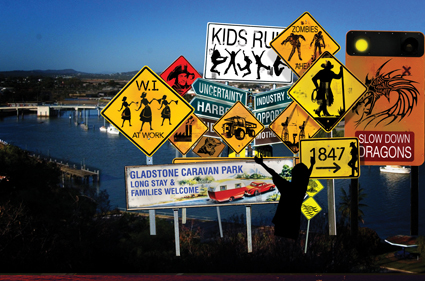
Boomtown, Queensland Festival of Music
Queensland Music Festival
The Queensland Music Festival has always done things big but this year’s director, jazz trumpeter James Morrison, has gone really big. Continuing the festival’s state-wide focus there’s a large-scale community event coming up in Gladstone (18-21 July) and a huge performance in Tambo has already taken place at the end of June. Morrison is also trying to break the Guinness World Record for the largest orchestra (more than 6500 musicians) and the largest trumpet ensemble (more than 1200 players; July 13). More moderately-sized pleasures include 1001 Nights, a collaboration between physical theatre company Zen Zen Zo, Queensland Theatre Company and Persian and Middle Eastern ensemble Pezhvak (18-28 July) and the Brodsky Quartet’s Shostakovich celebration performing the composer’s entire string quartet cycle (19-21 July). The Brodsky Quartet will also team up with Brisbane’s Topology to present Elvis Costello’s Il Sogno (18 July).
Queensland Music Festival, various venues, 12-28 July; www.qmf.org.au
TeleScope online screenings, Melbourne International Film Festival
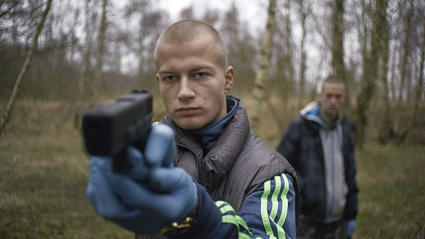
Northwest, Michael Noer
Melbourne International Film Festival is fast approaching and there’s a particularly exciting development for those of us who don’t reside in Melbourne. All films from the TeleScope: Visions from the EU program will be available for online screening around Australia (at a cost of $10 per stream). Twelve films will be available for 24 hours after they first screen at the festival and include films by directors Mark Cousins (UK), Katrin Grebbe (Germany), Sophie Letourneur (France) and Michael Noer (Denmark).
TeleScope: Visions from the EU, online screenings, Melbourne International Film Festival, 25 July-11 August http://miff.com.au/program-categories/telescope (There’s also a selection of previous festival fare available on iTunes – http://miff.com.au/itunes)
Intra-action, MOP Gallery
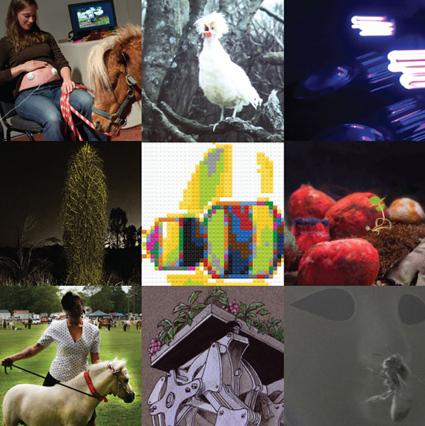
Intra-action, MOP Gallery
courtesy the artists
Intra-action, MOP Gallery
A companion event to the Australian Animal Studies Group Conference (University of Sydney 8-10 July), Intra-action is an exhibition featuring work by Australian and US artists exploring “multispecies entanglements” (website). Artists include Trish Adams whose Urban Swarming is a locative interactive work inspired by bees; Maria Fernanda Cardoso whose oeuvre includes performing fleas and a Museum of Copulatory Organs; and Andre Brodyk who creates images using genetically modified DNA.
Intra-action: Multispecies becomings in the Anthropocene, curators Eben Kirksey, Madeleine Boyd; MOP Gallery, opening 11-28 July, http://intraactionart.com/
Taking Centre Stage–Telling Indigenous stories in Australian theatres
As part of their Creative Forum series NIDA will present a panel discussion on “where indigenous arts practitioners in Australia fit into the mainstream theatre landscape” (press release). Discussion will be led by UK director Kristine Landon-Smith, currently a lecturer in Acting at NIDA who previously ran “black and minority ethnic” theatre company Tamasha, joined by Lydia Miller (Australia Council), Jane Harrison (playwright), Nakkiah Lui (playwright) and Glenn Shea (actor and playwright).
Creative Forum: Taking Centre Stage–Telling Indigenous stories in Australian theatres, NIDA Parade Theatres, 15 July, http://www.nida.edu.au/default.aspx?ArticleID=690
My Life in the Nude, Maude Davey
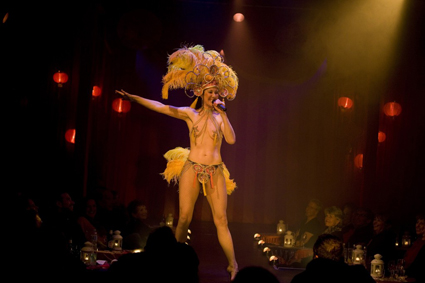
Maude Davey, My Life in the Nude
photo Ponch Hawkes
Maude Davey, My Life in the Nude
Even though it’s chilly, it seems some Melbourne performers can’t keep their clothes on (see last week’s entry on Finucane & Smith’s Glory Box Paradise). Maude Davey, member of Crying in Public Places and former artistic director of Vitalstatistix, is a veteran of the performance scene starting back when it was de rigueur to disrobe to be contemporary. She’s decided maybe it’s time to cover up but is going out with one last naked hurrah in this one-woman show, directed by twin sibling Anni Davey.
Maude Davey, My life in the Nude, till 21 July, La Mama Theatre, Carlton; http://lamama.com.au/
Ensemble Offspring Sizzle
Rapidly becoming an annual event is Ensemble Offspring’s Sizzle, a winter afternoon frolic at the Petersham Bowling Club. This year, curated by percussionist Bree van Rey, the Sizzle features contemporary classical music by John Cage, Erik Griswold and Elena Kats-Chernin in the mix with folk ballads by Grand Salvo and new and newly arranged works for the Bellevue Public Wind Ensemble. And of course, there’s also the lawn bowls.
Sizzle, Sunday 14 July, 3pm, Petersham Bowling Club, http://ensembleoffspring.com/the-music/upcoming-shows/sizzle-2/
Persona, Fraught Outfit
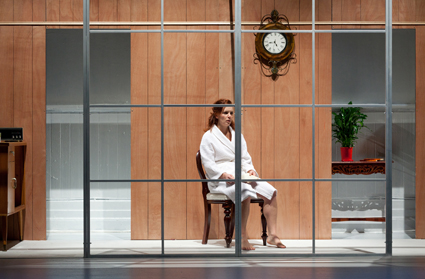
Meredith Penman, Persona
photo Pia Johnson
Meredith Penman, Persona
In RT112 Andrew Fuhrmann wrote about Fraught Outfit’s adaptation of Ingmar Bergman’s Persona: “In order to escape the cinema-face and rise above a mere capitulation of doubtful events, Persona must be de-faced for the stage. It must discover, to use the vocabulary of Deleuze and Guattari… the ancient ‘volume-cavity system’ of the theatre, or the theatre-body.” For those who missed it last time there are a few days left to catch its reprise at Malthouse before it moves to Belvoir.
Fraught Outfit, Persona, based on the film by Ingmar Bergman, conceived by Adena Jacobs, Dayna Morrissey & Danny Pettingill; directed by Adena Jacobs; Malthouse, Melbourne; until 14 July; www.malthousetheatre.com.au; Belvoir 24 July-18 Aug, http://belvoir.com.au
Personal Space, Tanya Lee
Personal Space at Fremantle Arts Centre is a series of playful performative interactions with the flatlands of suburbia. In her debut solo exhibition Tanya Lee creates short videos of figures elaborately camouflaged to match the fencing of the houses they walk past. While part of the landscape the wandering figures are also essentially walled or fenced in.
Personal Space, Tanya Lee, Fremantle Arts Centre, until July 21http://fac.org.au
Instrument Builder’s Project, Yogyakarta
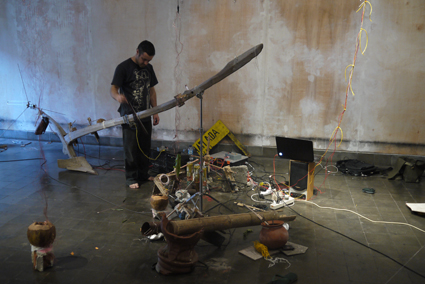
Dylan Martorell, Instrument Builder’s Project, Yogyakarta
photo Joel Stern
Dylan Martorell, Instrument Builder’s Project, Yogyakarta
A merry band of Australian instrument makers has been in residence at the Indonesian Contemporary Art Network (iCAN) in Yogyakarta working with local artists “to create new sounds and new ways of playing” (website). Co-curator Joel Stern tells us that one team, Pia van Gelder, Michael Candy and Andreas Saigain will actually be installing their sensor ‘instruments’ on the side of Merapi volcano. For those on the balmy isle, the residency will culminate in a performance and discussion.
Instrument Builder’s Project, curators Joel Stern, Kristi Monfries, artists Michael Candy, Rodney Cooper, Dylan Martorell, Pia Van Gelder, Ardi M P Gunawan, Asep Nata, Lintang Radittya, Andreas Siagian, Wukir Suryadi; iCAN (Indonesian Contemporary Art Network); Yogyakarta;
https://www.facebook.com/pages/Indonesia-Contemporary-Art-Network-iCAN
Still in the loop
NAIDOC Week
7-14 July
http://www.naidoc.org.au/
Live and Deadly, Carriageworks
27 Jun-1 Aug
http://www.carriageworks.com.au/?page=Event&event=LIVE-AND-DEADLY
My Country, I Still Call Australia Home: Contemporary Art from Black Australia
Queensland Art Gallery/Gallery of Modern Art, 1 June-7 October
http://www.qagoma.qld.gov.au/exhibitions/current/my_country
Collaborateurs, Artereal
3-11 July
http://artereal.com.au/home/collaborateurs
With Open Arms
Blindside, 10-13 July
http://www.blindside.org.au/2013/screen-series.shtml
Revelation Film Festival
various venues, Perth, 4-12 July
www.revelationfilmfest.org/
Show Off, Performance Space
till 17 July; Carriageworks
www.performancespace.com.au/2013/show-off-season/
Helium Season, Malthouse
8 June-5 Oct, see website for following productions
www.malthousetheatre.com.au/helium-2013/
Finucane & Smith’s The Glory Box…Paradise
45 Downstairs, Melbourne, 10 July -11 August
http://www.fortyfivedownstairs.com/events/
Fright or Flight, 3 is a Crowd,
Judith Wright Centre, Brisbane, 6-13 July judithwrightcentre.com/event/fright_or_flight
Anne Ferran, Box of Birds
Stills Gallery, Sydney; 26 June to 27 July 2013
www.stillsgallery.com.au
Vocal Folds, Gertrude Contemporary
21 June-20 July; performances 11 July, 18 July
www.gertrude.org.au/exhibitions
RealTime issue #115 June-July 2013 pg. web
© RealTime ; for permission to reproduce apply to realtime@realtimearts.net
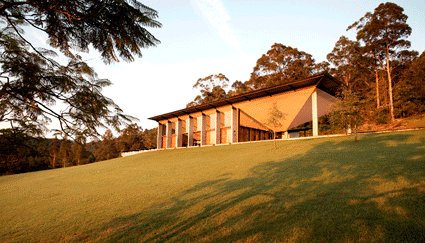
Bundanon Trust
photos Keith Saunders
Bundanon Trust
Bundanon Artist Residencies
Bundanon Trust, 45 minutes out of Nowra in regional NSW, offers a year-long program of residencies in a range of cottages and studios across the homestead and Riversdale sites. Allowing time for research and collaboration, residencies are open to all artists and groups working in all artforms.
Applications close 2 August; www.bundanon.com.au/content/residencies
2013 INSITE Award
Presented by the Australian Writers’ Guild (AWG) and the Adelaide Film Festival, the INSITE award is for unproduced screenplays. The award is open for AWG members. A submission requires a synopsis and sample of the work. (You can join AWG as part of the submission process.) The winner will be invited to meet selected directors and producers at the 2013 Adelaide Film Festival to discuss potential development.
Deadline 26 July, www.awg.com.au
Still in the loop
Abbotsford Convent, Spiritous 2014
Applications due 29 July 2013
http://www.abbotsfordconvent.com.au/venues-hire/cultural-programming
France 24 – Rfi Web Documentary Visa D’or Award 2013
Entry deadline 26 July, 2013
http://www.france24.com/en/webdocumentary-award-2013
Digital Associates Program, QUT Creative Industries Precinct
Friday 12 July 2013
http://www.ciprecinct.qut.edu.au/dap/
Waverley Artist In Residence Program 2014
Deadline Monday 22 July 2013; http://www.waverley.nsw.gov.au/things_to_do/arts_and_culture/AIR_program/about_the_program
PauseFest
Registration and final design submission August 15; http://pausefest.com.au/download_docs/pausefest2014_eoi_details.pdf
Australia Council upcoming deadlines
(for full list see http://www.australiacouncil.gov.au/grants)
Art Fare: Australian Art Export, 12 July 2013
http://www.australiacouncil.gov.au/grants/2013/artfare-12-july
Aboriginal and Torres Strait Islander Arts: Presentation and Promotion 16 July 2013
http://www.australiacouncil.gov.au/grants/2013/aboriginal-and-torres-strait-islander-arts-presentation-and-promotion-16-july
Aboriginal and Torres Strait Islander Arts: Skills and Arts Development 16 July 2013
http://www.australiacouncil.gov.au/grants/2013/aboriginal-and-torres-strait-islander-arts-skills-and-arts-development-16-july
Aboriginal and Torres Strait Islander Arts: Indigenous Arts Workers’ Program, 16 July 2013
http://www.australiacouncil.gov.au/grants/2013/indigenous-arts-workers-program
Hopscotch, 19 July 2013
(for Market Development; National Touring, International touring)
http://www.australiacouncil.gov.au/grants/2013/hopscotch
Music: International Pathways – Round 4, 22 July 2013
http://www.australiacouncil.gov.au/grants/2013/music-international-pathways-22-july
Music: Peggy Glanville-Hicks Residency22 July 2013
http://www.australiacouncil.gov.au/grants/2013/peggy-glanville-hicks-residency
Emerging and Experimental Arts: Creative Australia – New (Art Creative Development), 01 August 2013
http://www.australiacouncil.gov.au/grants/2013/inter-arts-creative-australia-new-art-creative-development
Theatre: Cultural Leadership Skills Development, 05 August 2013
http://www.australiacouncil.gov.au/grants/2013/cultural-leadership-skills-development-theatre
Theatre: New Work, 5 August 2013
http://www.australiacouncil.gov.au/grants/2013/theatre-new-work
Theatre: Fellowships, 5 August 2013
http://www.australiacouncil.gov.au/grants/2013/theatre-fellowships
Creative Australia – Emerging Presenter, 12 August 2013
http://www.australiacouncil.gov.au/grants/2013/Creative-Australia-Emerging-Presenter
Creative Australia – New Digital Theatre, 12 August 2013
http://www.australiacouncil.gov.au/grants/2013/Creative-Australia-New-Digital-Theatre
RealTime issue #115 June-July 2013 pg. web
© RealTime ; for permission to reproduce apply to realtime@realtimearts.net
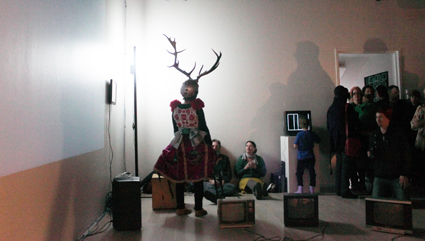
Selena de Carvalho, (un)popular culture
photo Nancy Mauro-Flude
Selena de Carvalho, (un)popular culture
There is a low hum of voice and technology as the artist kneels within a circle of television monitors. She wears a collage of ritualistic gear, a little Hungarian folk, a little found material. On her head an adapted bike helmet, sprouting antlers, balances precariously. With smartphone amplified, she follows the instructions given by a male American voice. He guides a séance for the participants—this circle of obsolete devices.
Asked to hold hands (read cords) of those gathered, artist Selena de Carvalho becomes the conduit between the living and the dead as she attempts to make contact with a lost analogue television signal. I half expect to see a monitor flicker into life. There is so much electronic gear in this gallery space, surely something could flash us a message from the technological afterlife. It doesn’t.
De Carvalho’s (un)popular culture is part of Notorious R + D, an exhibited outcome of Networked Art Forms and Tactical Magick Faerie Circuits (NAF:TMFC), a festival developed by curator Nancy Mauro-Flude and producer Pip Stafford with CAST as part of the DARK MOFO festival. The provocatively long title covers a range of happenings including performances, symposia, radio broadcasts, networking events, exhibitions and workshops and the intentions behind NAF:TMFC are equally multifarious. Stafford describes it as an opportunity to connect a network of people working with similar materials, a chance to share skills among participants and a means to crack open the ‘case’ of technologies that we are often too scared to tinker with. Empowerment is a key expression and in this context hacking is far from a dirty word, instead a means to this end. Within what Mauro-Flude describes as a hothouse environment, eight local artists have made works in response to their NAF:TMFC experience.
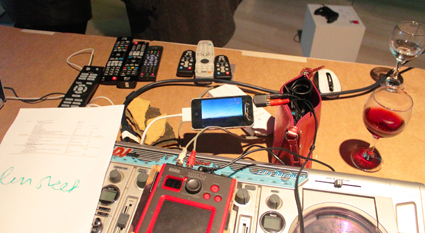
Networked Art Forms and Tactical Magick Faerie Circuits (NAF:TMFC) Presentation Desk. featuring Rahni Allen’s video stream from HELIUM BALLOON LAUNCH # 5 Smartphone Satellite Love Letter to the Universe TEST #1 ( SSLLUT #1 )
photo Nancy Mauro-Flude
Networked Art Forms and Tactical Magick Faerie Circuits (NAF:TMFC) Presentation Desk. featuring Rahni Allen’s video stream from HELIUM BALLOON LAUNCH # 5 Smartphone Satellite Love Letter to the Universe TEST #1 ( SSLLUT #1 )
The evening begins with Rahni Allan’s HELIUM BALLOON LAUNCH # 5, Smartphone Satellite Love Letter to the Universe TEST #1 (SSLLUT #1 – see video of launch by Emma Bugg). In an artist’s statement, she describes herself as being on a mission to communicate her love to the universe. The packed gallery empties into the courtyard to watch Allan, in astronaut-style overalls, release SSLUT #1—an android device strapped to a bunch of orange helium balloons. Launch successful, the crowd pours back in to watch a projected video call to the device. Amusingly, the image we receive is on its side (the gyro function perhaps), so we all tilt our heads accordingly. It is hard not to personify this small climbing phone as it sends back poor quality video like a tiny data-naut. We watch it until it stops—“we ran out of credit,” proclaims Stafford—and the crowd shifts focus. I wonder where SSLUT#1 went, with last frames showing it high above the city, looking down on the winding river at dusk.
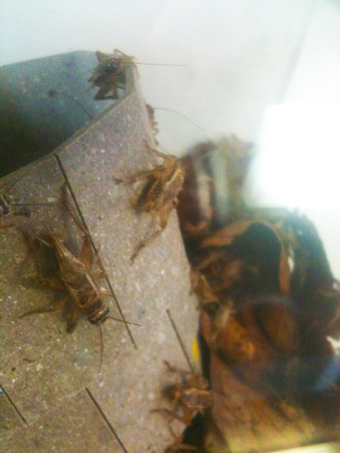
Astrid Joyce, Holla, detail still
photo Nick Smithies
Astrid Joyce, Holla, detail still
In Holla, Astrid Joyce eschews any plugged-in technology. The work is constructed of several clear perspex ‘speaker boxes’ fixed to the wall, containing tiny colonies of crickets nesting within leaf matter. In the dark of the gallery they come to life; we can listen in to their chatter through ‘amplifiers’ on the tops of the boxes. Joyce’s statement suggests that the work draws on an underpinning concept of technology—communication. The delicate, incessant squeaking of the crickets makes me think that this could be the sound of Twitter, as tiny missives roll endlessly into the Twittersphere. (See also Jon Drummond’s Twitter driven sound installation, part of Echosonics, UTS Gallery on realtime tv.)
Jeweller Emma Bugg has constructed a romantic response to NAF:TMFC. Using Instagram, Facebook and a blog site, she has crowd-sourced imagery of accidental hearts—in the footpath, in a fence, in the lichen on a rock. She has crafted a silver-smithed QR code to be worn on the body as a brooch. When the pin is scanned it connects directly to the gallery of found hearts. When I speak to her at the event, Bugg tells me that the call out has produced a kind of positive virus, where her ‘crowd’ is seeing hearts everywhere. If they are seeing hearts, Bugg thinks they’ll be thinking love, so her pin could be an index to a collective mind shift.
Perhaps it is appropriate that I review NAF:TMFC because it sits just outside my comfort zone. I embrace a range of technologies in my daily life, but there is a point at which my mind turns to white noise and the alternate language of artists like these flows over and around me without sticking. Initially I really felt that the aspiration for accessibility and empowerment wasn’t available to me and I would still argue that many will be locked out by the cult-like feel of the event. But with persistence, understanding came. The works, like those described above, where the heart, the ritual, the idea of frailty, are returned to technology, seem to capture the spirit of the endeavour. They hold something I can grasp or identify with. And with time, exploring the exhibition in a near empty gallery, I see that the collected works cultivate potential for play and discovery—qualities that chip away at the white noise and allow for a singular experience.
CAST, Networked Art Forms and Tactical Magick Faerie Circuits, curator Nancy Mauro-Flude, producer Pip Stafford, CAST facilitator/producer Kylie Johnson; http://tacticalmagick.net/; http://www.darkmofo.net.au/program/notorious-rplusd/
RealTime issue #115 June-July 2013 pg. web
© Judith Abell; for permission to reproduce apply to realtime@realtimearts.net
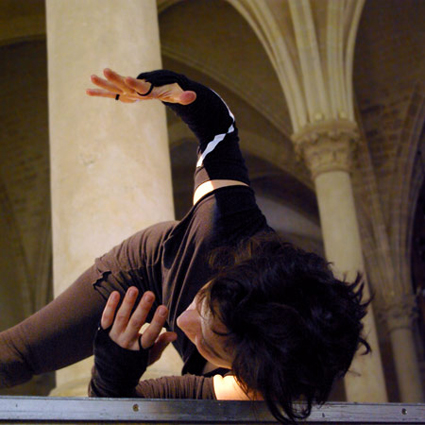
Myriam Gourfink, Breathing Monster
photo Nicolas Chaussy
Myriam Gourfink, Breathing Monster
After the discussion, debate and some rancour (see crikey.com) aroused by Myriam Gourfink and Kaspar Toeplitz’s Breathing Monster in ISEA2013 as part of Performance Space’s Switched On program, I thought it best to write plainly about the performance in order to make clear what it actually looked and felt like and possibly meant.
In Breathing Monster, French dancer and choreographic researcher Myriam Gourfink travels from one end of a platform [fluorescent lights at each end] to the other in two discrete moves, each comprising low, extremely slow turns—delicately balanced and predicated on two or more points of the body (hand, knee, foot, elbow) being temporarily in touch with the floor. Anxiety about imminent collapse passes, replaced by pleasure in the quiet beauty of seamless micro-movement pitched against bassist Kaspar Toeplitz’s spatially epic live score—built live from “’data noise’ generated through the minimal gestures of the dancer—creating an intermeshed monster of movement and sound” (program note).
In this 50-minute performance Gourfink takes 25 minutes to reach resting point midway along the platform before venturing on again, her body only occasionally revealing the fine muscular tremors that speak of stress. It’s not an easy performance to totally commit to, but there is the sense of overall flow (as one audience member suggested it would be fascinating to see the movement sped up on film, likely to reveal Gourfink as propelled like tumbleweed) and, in an intimate staging, the opportunity to take in the minutiae of the mechanics of a body shifting not unit by unit but as a totality—as a foot touches down, a hand turns slightly, an arm arcs away from the forward movement, a leg extends, toes push up. Shapes classical and unusual form and dissolve.
If you’ve experienced Matthew Day’s more immediately arresting work you’ll see a kinship with Gourfink’s performance in which our sense of time is equally suspended, all attention focused on the remarkable capacity of the body to enter strange states of being. If Day vibrates in his circular trajectories, Gourfink oscillates cyclically between stasis and perpetual motion on her linear journey. With Day there’s a dramatic sense of evolution, with Gourfink the mood is near meditative. However, our contemplation in the Sydney Performance is challenged by Toeplitz’s Cell Block-rattling live score. There’s no obvious one-to-one correlation between movement and sound, the music has its own character, from the opening rumble through to swelling organ-like tones, metallic waves, siren-like keenings, blips, decelerating glides and, in the final stage, wild bass flurries, a chilling high buzz (the dancer’s body presumably at its most stressed) and then a slow, deep, windy descent into silence long after Gourfink has ceased moving, as nerves and muscles finally come to rest.
Some nonsensical reviewing, with no eye to detail or motivation, has judged Breathing Monster in the same terms as it did the performances of the Nederlands Dans Theatre, visiting at the same time as Gourfink. These artists’ respective creations are of very different orders, Gourfink’s offering not only a thing of beauty in itself, if taxingly minimal for some audiences, but movement that speaks of investigation and potential for dance more broadly—as does Matthew Day’s more theatrical assaying of the body at the outer limits of dance.
Breathing Monster’s being programmed in data-mad ISEA2013 makes some kind of sense, at least rhetorically. It’s not at all clear how Toeplitz’s computer is registering the dancer’s “minimal gestures” as “data-noise” and treating them as a score for improvisation. Had the data come directly from a wired-up Gourfink the notion of data flow might been convincing but, without a program note explaining Toepltiz’s process, Breathing Monster manifested as a quite indeterminant creature. The artist on her website puts it this way:
“This breathing monster is about stillness and the powerful presence of the sound: the apparent stillness of the dancer whose microscopic movements are based on the intense activity of her deep-breathing, and the sheer weight of the sounds produced by the bass as transformed—in real time—by the computer, and also disturbed by the data-noise created by the dancers minimal gestures.”
It would appear then, in the absence of wiring or cameras, that the term “data-noise” is at best metaphorical. In an ISEA in which much movement was generated interactively between audiences and technology, here was a work by a dance artist and a musician ‘interacting’ quite conventionally, if with powerful physicality and musicality.
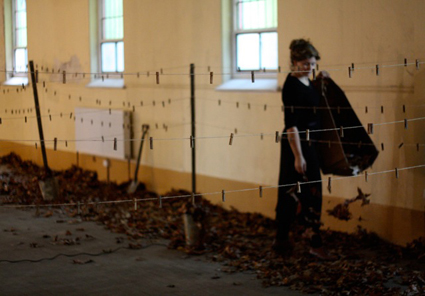
Jody Cleaver in the Chapel installing her site responsive Spiritous project Within/Out. 1-24 June 2013, Sacred Heart Oratory, Abbotsford Convent
Abbotsford Convent, Spiritous 2014
The Abbotsford Convent Foundation in Melbourne is calling for proposals for their site-specific residency program Spiritous. All artforms are considered and applicants should address ideas around “Indigenous heritage, local culture, history, geographical position and the diversity of the local demographic” (website).
Applications due 29 July 2013; http://www.abbotsfordconvent.com.au/venues-hire/cultural-programming
Quickfire residencies, Performance Space
Just announced 5 x 1 week residencies across August/September for artists at any stage in their careers to start the development of a performance work. You'll receive space, some technical and curatorial support and a stipend.
Deadline 8 July, 2013, 5pm; http://www.performancespace.com.au/2013/call-for-proposals-quickfire-residency-program/
France 24 – Rfi Web Documentary Visa D’or Award 2013
Run by the international TV news channel FRANCE 24, radio station RFI and the festival for photojournalism Visa pour l’Image, this competition offers a whopping 8000 euro prize to the best web documentary. Defined as an “online documentary that uses image, text, sound and videos and has an interactive dimension,” interesting examples can be viewed on their website. Entries must have been made in the last year and be in either English or French.
Entry deadline: July 26th, http://www.france24.com/en/webdocumentary-award-2013
ADT Youth Ensemble
South Australia's leading dance company Australian Dance Theatre is forming a youth ensemble. Dancers aged between 14 and 18 are invited to apply to participate in tuition and rehearsals across school terms.
Applications due July 5, auditions July 11; http://adt.org.au/
Still in the loop
Dancehouse, Housemates Performance 2014
Deadline (extended) July 5; http://www.dancehouse.com.au/research/researchdetails.php?id=81
Small Screen 2014, Screen Space
Deadline 8 July
http://screenspace.com/proposals.html
Digital Associates Program, QUT Creative Industries Precinct
Friday 12 July 2013
http://www.ciprecinct.qut.edu.au/dap/
Waverley Artist In Residence Program 2014
Deadline Monday 22 July 2013; http://www.waverley.nsw.gov.au/things_to_do/arts_and_culture/AIR_program/about_the_program
PauseFest
Registration and final design submission August 15; http://pausefest.com.au/download_docs/pausefest2014_eoi_details.pdf
Australia Council upcoming deadlines
(for full list see http://www.australiacouncil.gov.au/grants)
Art Fare: Australian Art Export, 12 July 2013
http://www.australiacouncil.gov.au/grants/2013/artfare-12-july
Aboriginal and Torres Strait Islander Arts: Presentation and Promotion 16 July 2013
http://www.australiacouncil.gov.au/grants/2013/aboriginal-and-torres-strait-islander-arts-presentation-and-promotion-16-july
Aboriginal and Torres Strait Islander Arts: Skills and Arts Development 16 July 2013
http://www.australiacouncil.gov.au/grants/2013/aboriginal-and-torres-strait-islander-arts-skills-and-arts-development-16-july
Aboriginal and Torres Strait Islander Arts: Indigenous Arts Workers' Program, 16 July 2013
http://www.australiacouncil.gov.au/grants/2013/indigenous-arts-workers-program
Hopscotch, 19 July 2013
(for Market Development; National Touring, International touring)
http://www.australiacouncil.gov.au/grants/2013/hopscotch
Music: International Pathways – Round 4, 22 July 2013
http://www.australiacouncil.gov.au/grants/2013/music-international-pathways-22-july
Music: Peggy Glanville-Hicks Residency22 July 2013
http://www.australiacouncil.gov.au/grants/2013/peggy-glanville-hicks-residency
Emerging and Experimental Arts: Creative Australia – New (Art Creative Development), 01 August 2013
http://www.australiacouncil.gov.au/grants/2013/inter-arts-creative-australia-new-art-creative-development
Theatre: Cultural Leadership Skills Development, 05 August 2013
http://www.australiacouncil.gov.au/grants/2013/cultural-leadership-skills-development-theatre
Theatre: New Work, 5 August 2013
http://www.australiacouncil.gov.au/grants/2013/theatre-new-work
Theatre: Fellowships, 5 August 2013
http://www.australiacouncil.gov.au/grants/2013/theatre-fellowships
Creative Australia – Emerging Presenter, 12 August 2013
http://www.australiacouncil.gov.au/grants/2013/Creative-Australia-Emerging-Presenter
Creative Australia – New Digital Theatre, 12 August 2013
http://www.australiacouncil.gov.au/grants/2013/Creative-Australia-New-Digital-Theatre
RealTime issue #115 June-July 2013 pg. web
© RealTime ; for permission to reproduce apply to realtime@realtimearts.net
NAIDOC Week
The second week of July brings NAIDOC week celebrating Aboriginal and Torres Strait Islander people and culture. This year’s theme, “We value the vision: Yirrkala Bark Petitions 1963,” commemorates the Yolgnu people’s missive to the Australian House of Representatives in which they protested mining in Arnhem Land and demanded recognition of the traditional owners and their land rights. There is an enormous range of activities across all states including the NAIDOC Awards, performances and screenings. Check the website for activities near you.
NAIDOC Week, national, 7-14 July http://www.naidoc.org.au/
For more on Yirrkala Bark Petitions see http://australia.gov.au/about-australia/australian-story/bark-petitions-indigenous-art
Live and Deadly, Carriageworks
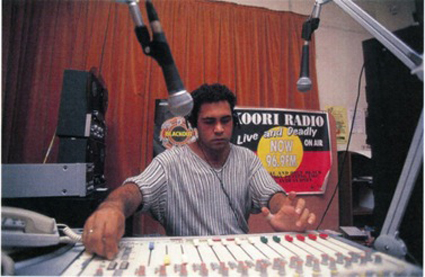
Trevor Dodds – Koori Radio 93.7FM Presenter
courtesy of Gadigal Information Service
Trevor Dodds – Koori Radio 93.7FM Presenter
Extending the NAIDOC week spirit across the month Live and Deadly celebrates 20 years of the Gadigal Information Service in Redfern which also houses Koori Radio (93.7FM). Across July Carriageworks will host an exhibition of archives, photos, films and radio recordings documenting this vital and groundbreaking community organisation. There’s also live music including Klub Koori (July 4) and forums such as The Foundations of Koori Radio (July 4) and The Digital Future: Kooris in Space (July 25).
Live and Deadly, Carriageworks, 27 Jun-1 Aug; http://www.carriageworks.com.au/?page=Event&event=LIVE-AND-DEADLY
My Country, I Still Call Australia Home, Queensland Art Gallery
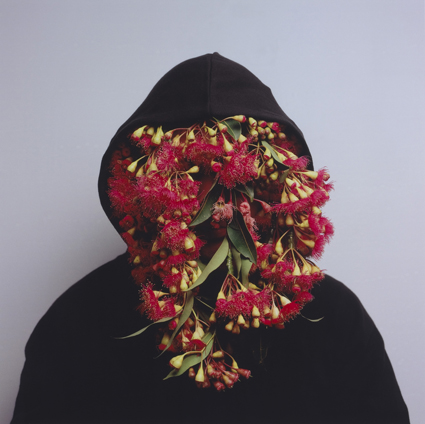
Christian Thompson (Bidjarra/Kunja people)
Black Gum 2 (from ‘Australian Graffiti’ series) 2008
Purchased 2008, The Queensland Art Gallery Foundation Grant, collection: Queensland Art Gallery
Christian Thompson (Bidjarra/Kunja people)
Black Gum 2 (from ‘Australian Graffiti’ series) 2008
This exhibition offers the largest display of Indigenous art to date for QAG/GOMA featuring the work of 116 artists from across the country. Curated by Bruce McLean the 300 works on display are divided into three themes: My History, My Life, My Country. Artists include Vernon Ah Kee, Michael Riley, Brook Andrew, Judy Watson, Warwick Thornton, Destiny Deacon, Fiona Foley and Christian Thompson. There are also two site-specific commissions from Reko Rennie and Megan Cope, and Gordon Hookey has been commissioned to make Kangaroo Crew, a large-scale interactive work for the children’s centre. Accompanying the exhibition is a screening program at the cinematheque, My Life as I Live It: First Peoples and Black Cinema.
My Country, I Still Call Australia Home: Contemporary Art from Black Australia, Queensland Art Gallery/Gallery of Modern Art, 1 June-7 October; http://www.qagoma.qld.gov.au/exhibitions/current/my_country
The Western Australian Composers Project Concerts, PICA
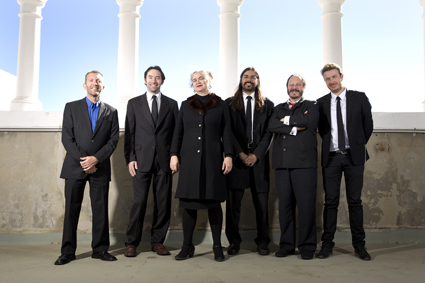
Decibel in the PICA Clock Tower
photo Brad Serls
Decibel in the PICA Clock Tower
While PICA is undergoing some upheaval with urgent building repairs that have meant the postponement of the exhibition Improvised Sound Project, there’s still plenty going on. Decibel have been in residence with the Western Australian Composers Project presenting open rehearsals and honing their compositional methods and innovative score reading systems. The residency concludes with two concerts featuring works by Western Australian composers Christopher Tonkin, Rachael Dease, Sam Gillies, Johannes Luebbers, Henry Anderson and Decibel members Cat Hope, Lindsay Vickery and Stuart James.
The Western Australian Composers Project Concerts, PICA, 5 & 6 July, 6.30pm; http://www.pica.org.au/view/WA+Composers+Project+Residency/1664/
The Glory Box…Paradise, Finucane & Smith
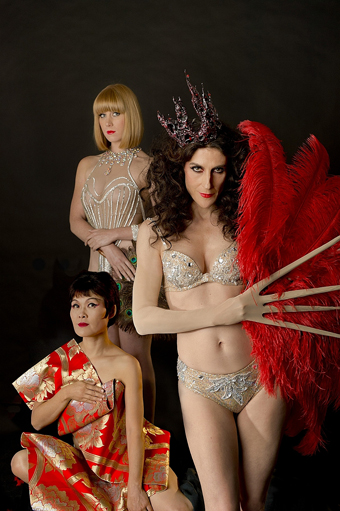
(l-r) Yumi Umiumare, Holly Durant, Moira Finucane, Glory Bok…Paradise
photo Jodie Hutchinson
(l-r) Yumi Umiumare, Holly Durant, Moira Finucane, Glory Bok…Paradise
Moira Finucane and Jackie Smith have been presenting bent burlesque for around 20 years, leading the way for the recent resurgence of interest in naughty cabaret. They will be presenting their annual winter showcase at 45 Downstairs over July with special international guests “dance siren” Holly Durant from Paris and red hanky stripper Ursula Martinez from London as well as the always captivating Yumi Umiumare and Circus Oz Ring Mistress Sarah Ward. The show will then tour to the Festival de Internacional de Buenos Aires in Argentina in October.
Finucane & Smith’s The Glory Box…Paradise, 45 Downstairs, Melbourne, 10 July -11 August; http://www.fortyfivedownstairs.com/events/
Collaborateurs, Artereal
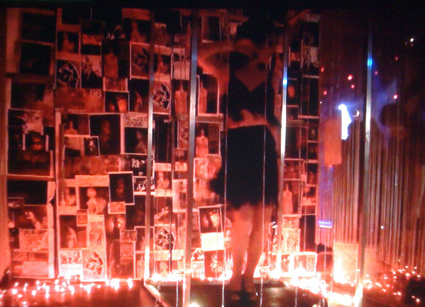
Bridie Connell, Free Fall performance 2012
Over nine days a three by three meter white cube at Artereal will be home to nine collaborative explorations. The resulting works will utilise a range of techniques from flower arranging to choreography and illustrate how “collaboration has moved into the mainstream of visual arts practice in the past decade” (press release). Artists include David Capra continuing his fetish for the Wizard of Oz here rendered in clay; brother and sister duo Michael and Karina Wikamto who will simultaneously make their family tree via computer generated images and sculptural collage; and Liam Benson working with Nic Atkins to create a pas-de-deux on masculinity.
Collaborateurs, artists Ella Barclay, Liam Benson, David Capra, Bridie Connell, Tully Arnot & Charles Dennington, Nola Diamantopoulos, Leahlani Johnson, Sylvia Schwenk, Michael & Karina Wikamto, Artereal, Rozelle, 3-11 July; http://artereal.com.au/home/collaborateurs
With Open Arms, Blindside
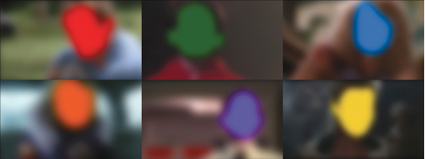
Daniel McKewen, Untitled (after Steven and John) (2013), single channel video installation
courtesy the artist
Daniel McKewen, Untitled (after Steven and John) (2013), single channel video installation
With Open Arms is an exhibition of video art reflecting the variety of ways young artists are manipulating the medium of video. Appropriated footage features strongly, for example Josephine Skinner has collected hundreds of YouTube clips of people singing “Hopelessly Devoted to You,” while Daniel McKewan explores abstraction via the filmic close-up. Antoinette J Citizen’s work takes a playfully subversive line as she attempts to cheat facial recognition software.
With Open Arms, curators Raymonda Rajkowski, Felicity Strong, also includes Tara Cook and Jonathon Nokes, Blindside, 10-13 July; http://www.blindside.org.au/2013/screen-series.shtml
Cache in Point, Red Rattler
This concert is a curatorial collaboration between vocalist Sonya Holowell and flautist Elia Bosshard who will be presenting “obscure classical music in an interdisciplinary landscape…with a ‘touch’ of theatrics” (website). The program includes works by Xenakis, Stockhausen, Schoenberg and Carl Vine juxtaposed with improvisations and dance for good measure.
Cache in Point, performers Elia Bosshard, Sonya Holowell, Ivan Cheng, Pat Keith, John Napier, Dean Kennedy, Jonathan Holowell, James McCaffrey, Liam O’Keefe, Red Rattler, Thursday, July 4, 7.30pm; https://www.facebook.com/events/575714642449943/?fref=ts
Christy Dena, The Block Digital Writing Residency
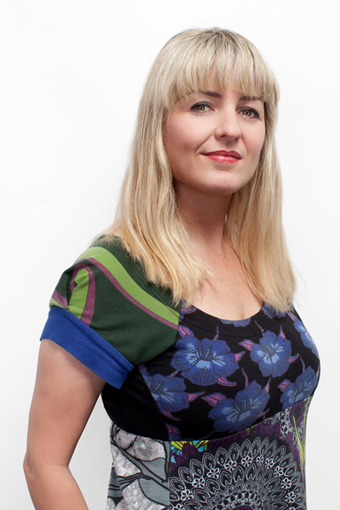
Christy Dena
Congratulations to sometime RealTime writer Christy Dena who has been awarded the inaugural QUT Digital Writing Residency. Her project, Robot University will explore the relationship between humans and robots and the development of ethics in this area. She will be collaborating with programmer Adam Single and sound composer Jacek Tuschewski utilising the game engine Unity to create an interactive narrative experience for viewers. The project is expected to be completed early 2014.
http://www.thecube.qut.edu.au/about/residency.php
Still in the loop
Revelation Film Festival
various venues, Perth, 4-12 July
www.revelationfilmfest.org/
Show Off, Performance Space
till 17 July; Carriageworks
www.performancespace.com.au/2013/show-off-season/
Helium Season, Malthouse
8 June-5 Oct, see website for following productions
www.malthousetheatre.com.au/helium-2013/
Fright or Flight, 3 is a Crowd,
Judith Wright Centre, Brisbane, 6-13 July judithwrightcentre.com/event/fright_or_flight
Anne Ferran, Box of Birds
Stills Gallery, Sydney; 26 June to 27 July 2013
www.stillsgallery.com.au
Vocal Folds, Gertrude Contemporary
21 June-20 July; performances 11 July, 18 July
www.gertrude.org.au/exhibitions
RealTime issue #115 June-July 2013 pg. web
© RealTime ; for permission to reproduce apply to realtime@realtimearts.net
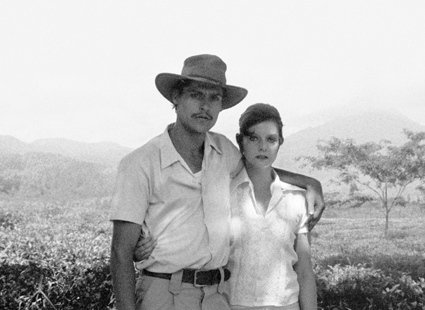
Tabu
With the hype that accompanied it long behind us, it seems fair to say today that Michel Hazanavicius’ The Artist (2011) was little more than a parlour trick: a blatant retelling of Singin' in the Rain that convinced moviegoers it was original; a picture with wall-to-wall music and diegetic sound that convinced them it was silent. It was trickle-down formalism: the inevitable middlebrow stalagmite formed by the steady dripping over time of more ambitious and avant-garde films like Guy Maddin's Eisenstein-Lang mash-up, The Heart of the World (2000), and Steven Soderbergh's cold, airlessly note-perfect recreation of the Classic Hollywood Cinema in The Good German (2006).
Miguel Gomes' Tabu (2012) sits somewhere between Hazanavicius and his betters, but is nevertheless still a parlour trick. Without necessarily meaning to, it makes history disappear, and it is for this reason that it is both a much more interesting and much more problematic film than the Oscar winner that preceded it.
The film is broken up into two parts of roughly equal length. It opens with a prologue: a 1920s silent film about a heartbroken adventurer who, haunted by his dead lover, seeks refuge in the wilds of Africa. The film is being watched by Pilar (Teresa Madruga), a lonely middle-aged woman living in contemporary Lisbon. Pilar's loneliness is as acute as Rui Poças's photography is dismal and grey: her only contact is with an overeager suitor who falls asleep at the movies (Manuel Mesquita); her confused and aging neighbour, Aurora (Laura Soveral); and Aurora's Cape Verdean maid, Santa (Isabel Cardoso).
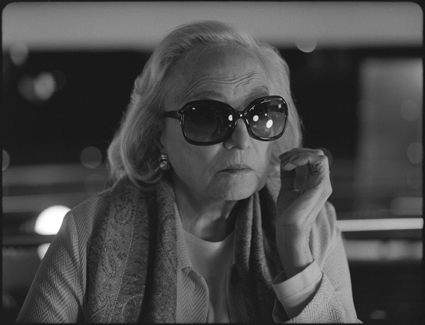
Tabu
Aurora grows ill and asks Pilar to track down one of her former lovers. Pilar does, but is too late: Ventura (Henrique Espírito Santo) never gets to reunite with the love of his life. And so the second part begins: Ventura tells Pilar and Santa the story of his doomed affair with Aurora (Ana Moreira) in an unnamed African colony years earlier. From austerity-hit Lisbon to the sun-drenched foothills of the fictional Mount Tabu, it's Out of Africa or The Short, Happy Life of Francis Macomber meets a Douglas Fairbanks romance-adventure, and while both parts of the film are shot in black-and-white the entire palette suddenly changes.
Like The Good German or Pablo Berger's silent bullfighting fairy-tale, Blancanieves (2012), The Artist was marked by an essential parallelism between its form and the setting of its narrative. Tabu's second part takes a different, rather more ambitious route. There is a distinct gap between the place and period Ventura is recalling—Portuguese Africa at the beginning of the 1960s—and the much older style in which it is being rendered. What's more, unlike Soderbergh's or Berger's, Gomes' rendering is intentionally unfastidious. Yes, when the characters move their mouths to speak, we hear no dialogue. But rather than The Artist or Blancanieve's title cards we get Ventura's style-inappropriate voiceover. Then when the characters open their mouths to sing—early doo-wop tunes, mostly—their lips and the lyrics are perfectly synched. So what is going on here?
The most likely explanation is that Tabu's second part is not the filmmaker's cinematic fetish object—or, at least, not completely—but rather to a significant extent Pilar's. It is a product of an imagination highly but imperfectly influenced by cinema: as in a dream, the films Pilar turns to escape her humdrum existence influence how she imagines Ventura's story.
While this reading might go some way towards explaining why the film seems reluctant to deal with questions about colonialism and its legacy—because they fall outside of the character's frame of reference—it need not go any way towards justifying it. In a European art cinema landscape that has grappled mightily with these questions—think Herzog, Denis, Haneke and the Dardennes, just to name a few—a film that approaches them with purely aesthetic answers is to be viewed with some degree of suspicion.
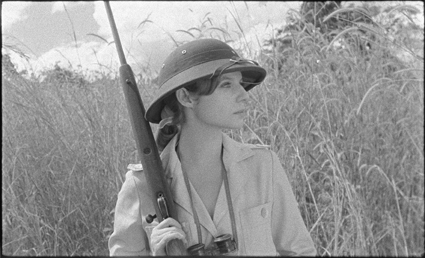
Tabu
Indeed, as idealised by Pilar and aestheticised by Gomes, Aurora's past can't help but come across as somehow preferable to the dreary present, even as black women serve lemonade on the patio and black men move the ping pong table that the white men have left out in the rain. If these glimpses of servitude are intended to come across as somehow damning, they fail to without a lot of heavy lifting from the viewer who must constantly struggle against the niggling feeling that the film is somehow longing for the colonial period. Yes, the appearance of these servants retrospectively situates Santa's life in Lisbon on a spectrum of experience that covers both the colonial and post-colonial periods. But these are hardly the Greek chorus of blue-collar cleaners that populate Sally Potter's Yes (2004), those unseen but all-seeing reminders of the system of oppression that allows these imperial follies to take place. They are, rather, akin to scenery.
What is being explored here, first and foremost, is a romance between two privileged whites: colonial Africa is a setting like any other, seismic events potential plot points, history a mere surface. Along with films like Claire Denis' White Material (2009), I occasionally found myself comparing Tabu unfavourably to Quentin Tarantino's Inglorious Basterds (2009) and Django Unchained (2012). Tarantino shares Gomes' impulse towards homage and bricolage, but to degrees of success that are open to debate, also seeks to channel that impulse towards at least some kind of historical inquiry. Tarantino may be the least theoretical, least philosophical filmmaker working today, but he nevertheless uses his ultra-cinematic style to place certain problems front and centre. Tabu, in striking contrast to this, uses its style to brush such problems aside.
Tabu, director Miguel Gomes, distributor Palace Films; http://www.palacecinemas.com.au/movies/tabu/
See also Philip Brophy’s take on Tarantino’s soundtracking of Django Unchained in RT114’s Audiovision
RealTime issue #115 June-July 2013 pg. web
© Matthew Clayfield; for permission to reproduce apply to realtime@realtimearts.net









![Soda_Jerk, The Phoenix Portal [2005]](https://www.realtime.org.au/wp-content/uploads/art/68/6806_loop_sodajerk_phoenix.jpg)












































 Opportunities for focused debate on the arts in Australia are somewhat rare. The Currency House Platform Papers series provides an important forum and addresses a range of issues around the changes or decline (whichever way you see it) in Australian arts practices and major performing arts institutions. A glance through the catalogue suggests a reasonable commitment to music from a range of voices, albeit one primarily focused on contemporary classical music and jazz.
Opportunities for focused debate on the arts in Australia are somewhat rare. The Currency House Platform Papers series provides an important forum and addresses a range of issues around the changes or decline (whichever way you see it) in Australian arts practices and major performing arts institutions. A glance through the catalogue suggests a reasonable commitment to music from a range of voices, albeit one primarily focused on contemporary classical music and jazz. 





























